Home » 出版物
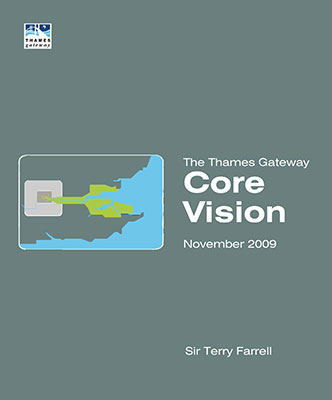

The Thames Gateway Core Vision
November 2009
As part of our work on the Thames Estuary, Farrells created a core vision for the area in 2009, building upon the Parklands Model.
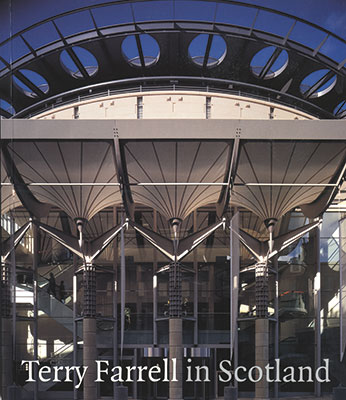

Terry Farrell in Scotland
This book explores the philosophy and implementation of responding to context in creating sensitive, yet innovative and bold, interventions to the design culture of a capital.
Farrells designed three major buildings and two public squares in the capital, Edinburgh, including the Exchange Financial District master plan and the Edinburgh International Conference Centre.
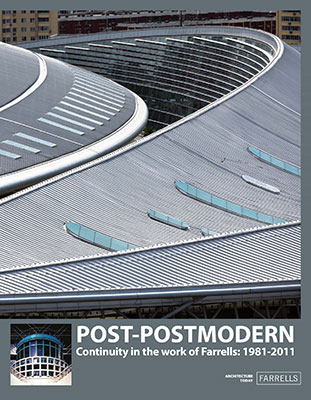

Post-Postmodern
Continuity in the work of Farrells: 1981-2011
“Postmodernism was not a style: it was a period of profound change that affected all aspects of our culture, not just architecture.” – Professor Colin Fournier on the legacy of Postmodernism and Farrells work.
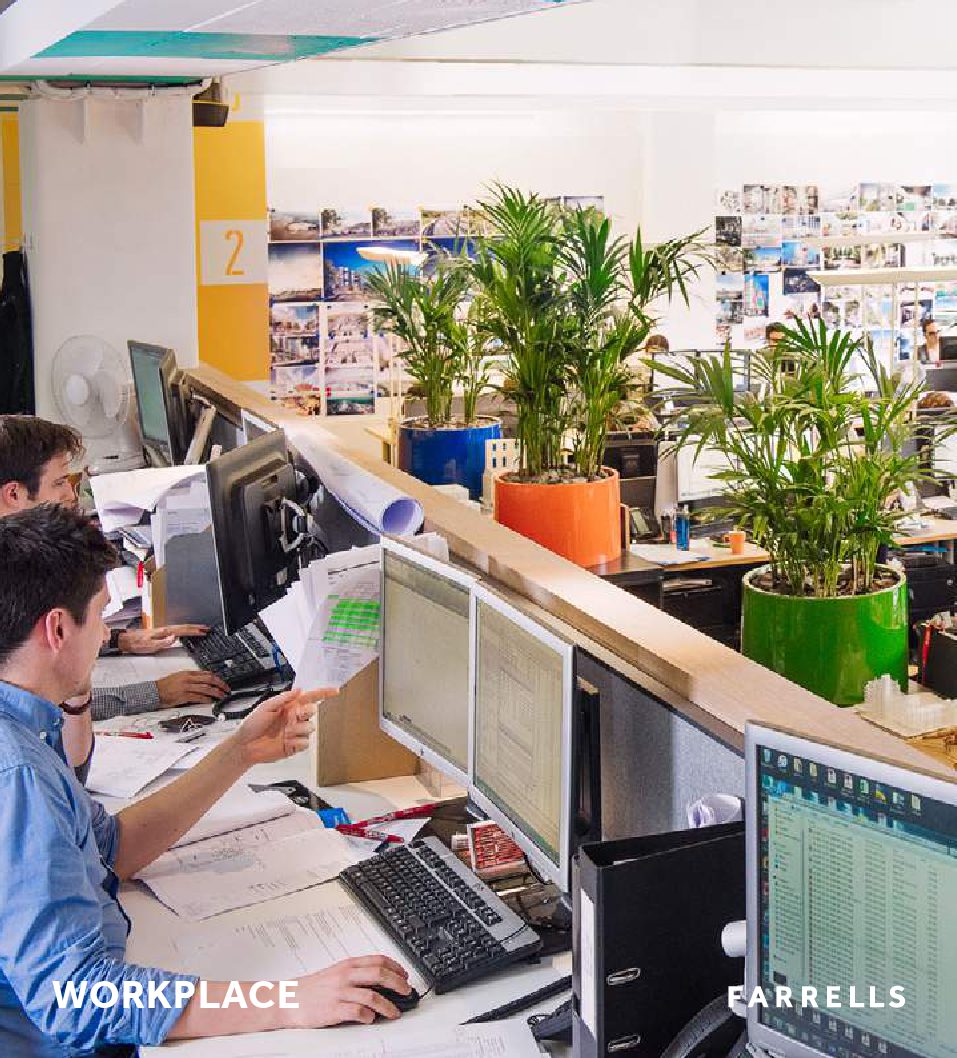

Farrells Office Projects
Farrells London
There is a radical transformation underway for workspace in London and the way it is designed, marketed and occupied. New emerging models for co-working, social enterprises and different types of ownership are rapidly changing the established paradigm of ‘CAT A’ commercial space prevalent in the capital over the last 20 years. Our challenge as practitioners, designers and occupiers is to go beyond the trend and to understand the deeper socio-economic shifts and changes informing this new ‘rental economy’.
Farrells has extensive experience in this area spanning five decades. From the TVam studios in Camden (recently voted ‘Britain’s most maverick building’ by the Royal Academy) to the office buildings starting on site at Royal Albert Dock which are unique to the UK market. We have always been at the forefront of thinking about the modern workplace. Our recently established research unit within the ‘Farrells Laboratory’ at the Hatton Street Studios looks into the past, present and future of workplace design and this innovative thinking is informing our projects.
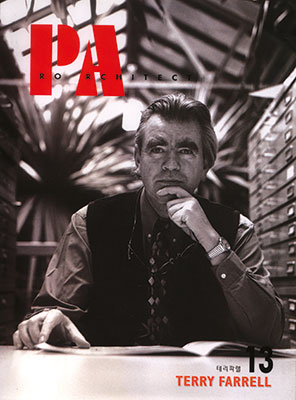

Pro Architect 13
Sir Terry Farrell
Published in 1999, the contemporarily bi-monthly Korean magazine Pro Architect focused issue 13 on Sir Terry Farrell and Farrells projects, including TV-am and Vauxhall Cross.
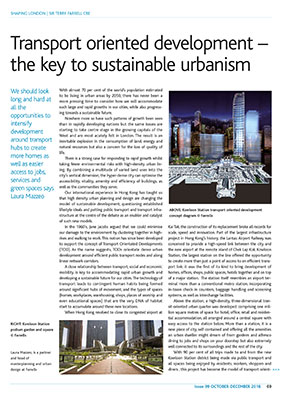

Transport oriented development – the key to sustainable urbanism
Planning in London October 2016
We should look long and hard at all the opportunities to intensify development around transport hubs to create more homes as well as easier access to jobs, services and green spaces says Farrells Managing Partner Laura Mazzeo.
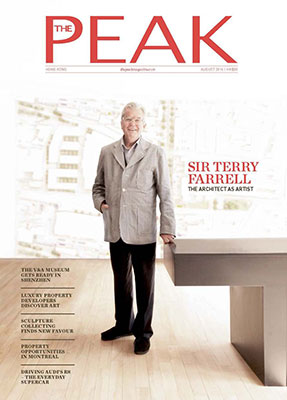

A Sir, not a Star
Interview with The Peak Magazine
“Sir Terry Farrell is responsible for some of Hong Kong’s best known landmarks. His work is not yet done, and his fondness for bridging old and new remains the key to his thinking.” Dominique Afacan interviews Sir Terry for The Peak Magazine.
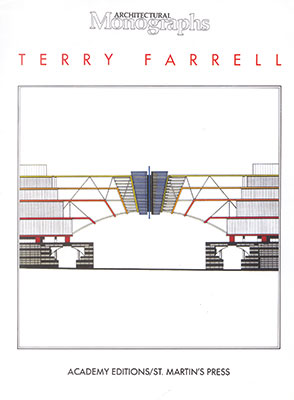

Terry Farrell
The Master Architect Series
The Master Architect Series is a series of monographs on some of the greatest architects and architectural firms of our time.
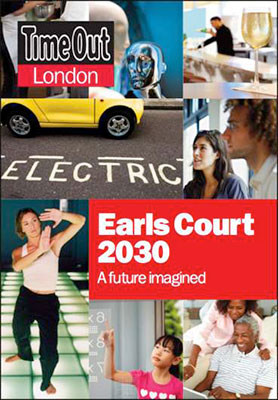

Earls Court 2030
A future imagined
A Time Out supplement “fast-forwarding to the furture and imagining what Earls Court could be like in 2030.”
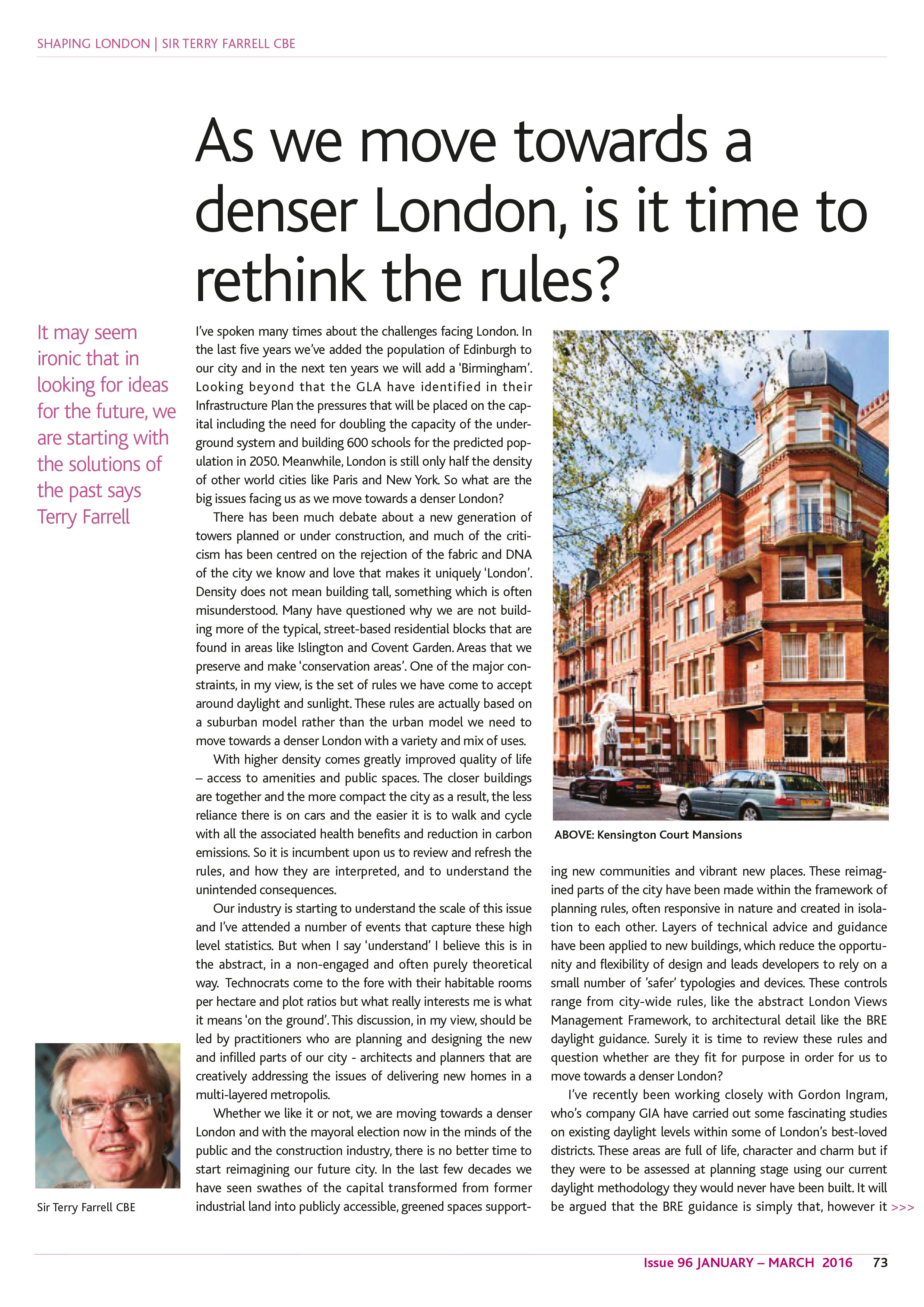

As we move towards a denser London, is it time to rethink the rules?
Planning in London January 2016
It may seem ironic that in looking for ideas for the future, we are starting with the solutions of the past says Sir Farrell – a discussion piece on the issues facing us as we move towards a denser London.
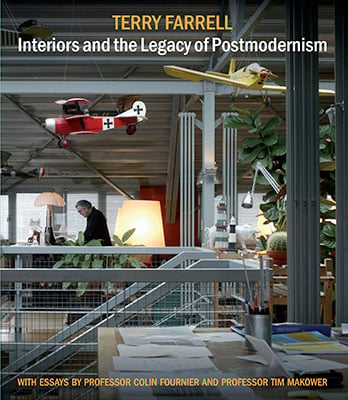

Interiors and the Legacy of Postmodernism
With essays by Professor Colin Fournier and Professor Tim Makower
As well as the original design for TV-am, this book includes a dozen of Sir Terry Farrell’s most striking interiors, such as the Charles Jencks House, Upwood House, and Charing Cross Station.
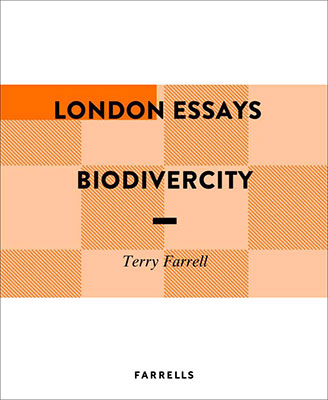

Biodivercity
London Essays
“Far from being bad for nature, London’s development can bolster London’s claims to become a National Park City.” – an essay by Sir Terry Farrell for the Centre for London’s ‘London Essays’.
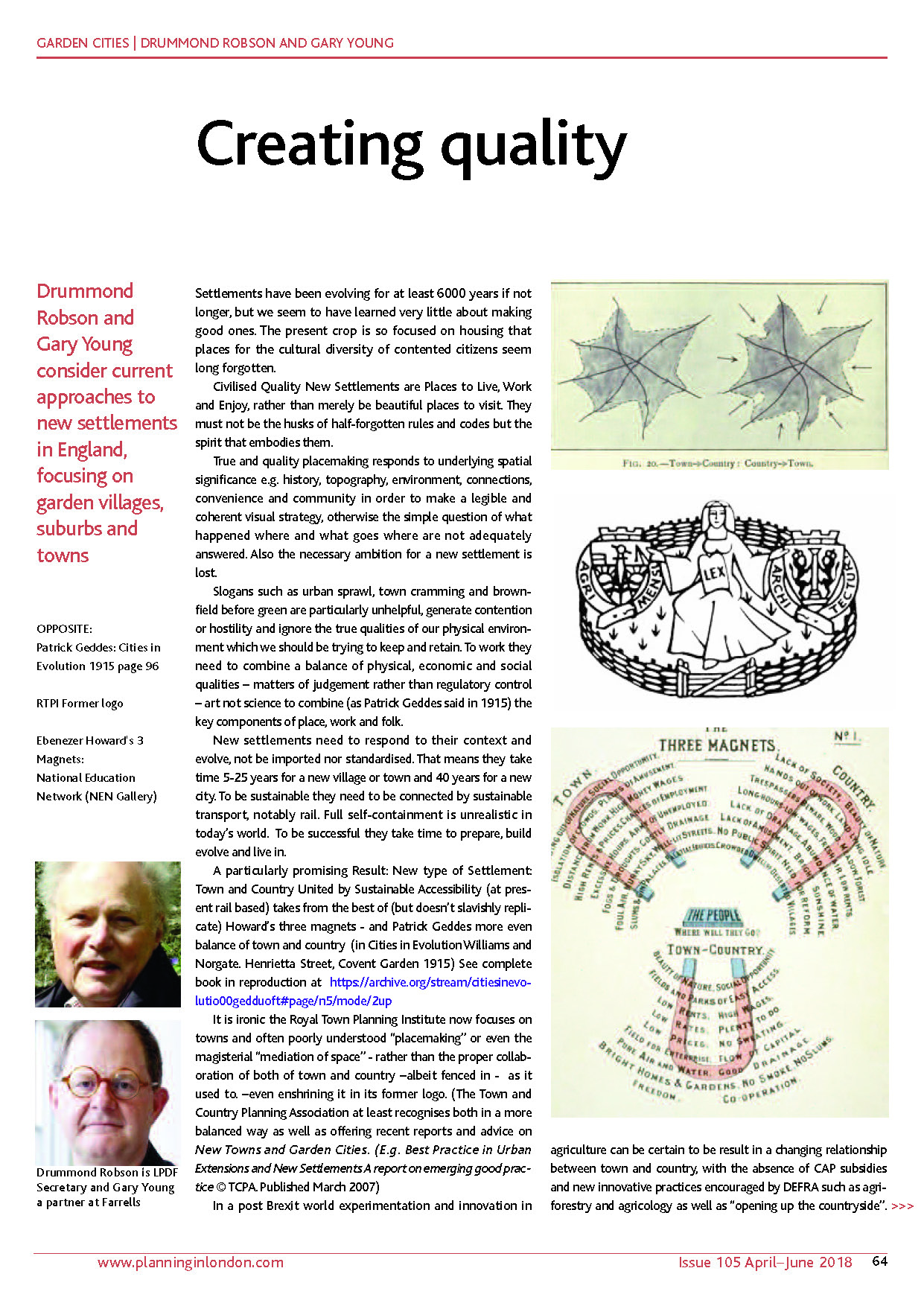

Creating quality – Garden Cities
Planning in London April 2018
Settlements have been evolving for at least 6000 years if not longer, but we seem to have learned very little about making good ones. The present crop is so focused on housing that places for the cultural diversity of contented citizens seem long forgotten.
Civilised Quality New Settlements are Places to Live, Work and Enjoy, rather than merely be beautiful places to visit. They must not be the husks of half-forgotten rules and codes but the spirit that embodies them.
True and quality placemaking responds to underlying spatial significance e.g. history, topography, environment, connections, convenience and community in order to make a legible and coherent visual strategy, otherwise the simple question of what happened where and what goes where are not adequately answered. Also, the necessary ambition for a new settlement is lost.
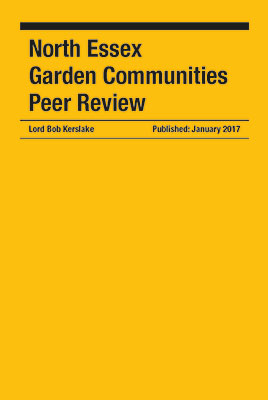

North Essex Garden Communities Peer Review
Lord Bob Kerslake
In October 2016 the Leaders and Chief Executives of Braintree, Colchester, Tendring and Essex Councils asked Lord Bob Kerslake to lead a peer review to look at their approach to delivering Garden Communities in North Essex. Farrells, with ystudio, supported the review.
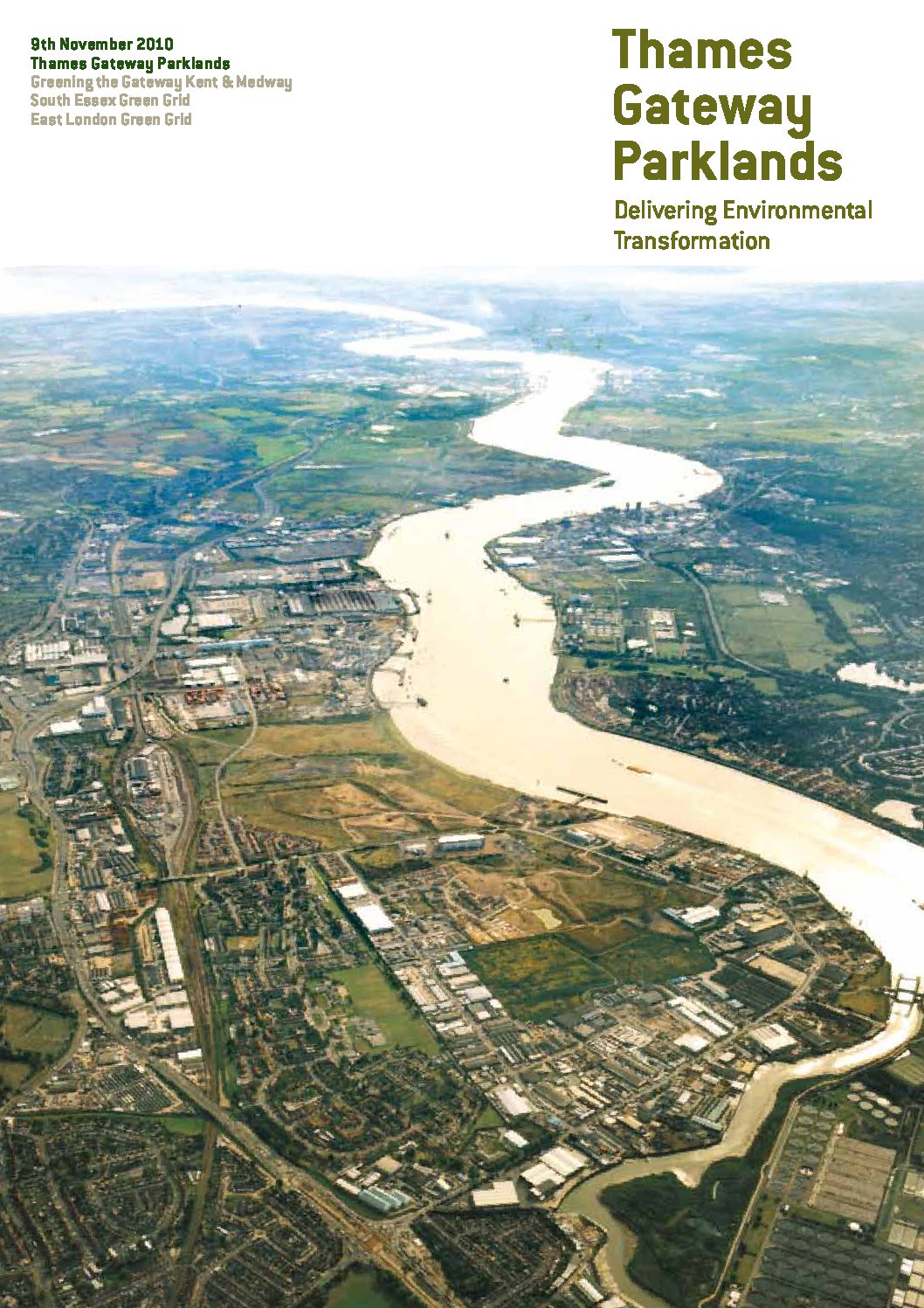

Thames Gateway Parklands
Delivering Environmental Transformation
“Working together in partnership, we know that the re-development of the Thames Gateway will only succeed if we create a network of green open spaces to enrich existing and new communities, attract investment and raise spirits.” – Sir Terry Farrell, Design Champion for the Thames Gateway.
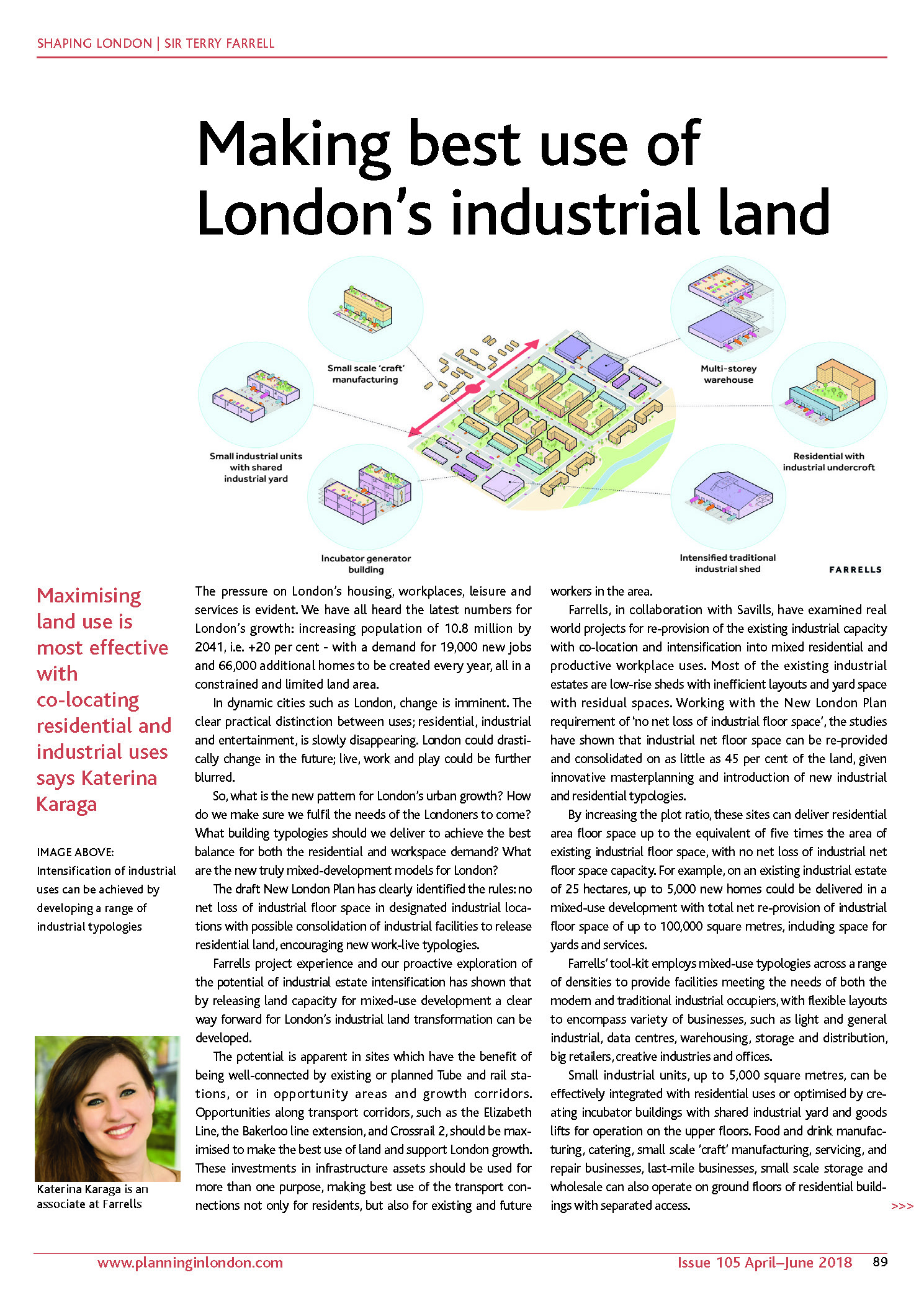

Making best use of London’s industrial land
Planning in London April 2018
The pressure on London’s housing, workplaces, leisure and services is evident. We have all heard the latest numbers for London’s growth: increasing population of 10.8 million by 2041, i.e. +20 percent – with a demand for 19,000 new jobs and 66,000 additional homes to be created every year, all in a constrained and limited land area.
In dynamic cities such as London, change is imminent. The clear practical distinction between uses; residential, industrial and entertainment, is slowly disappearing. London could drastically change in the future; live, work and play could be further blurred.
So, what is the new pattern for London’s urban growth? How do we make sure we fulfil the needs of the Londoners to come?What building typologies should we deliver to achieve the best balance for both the residential and workspace demand? What are the new truly mixed-development models for London?
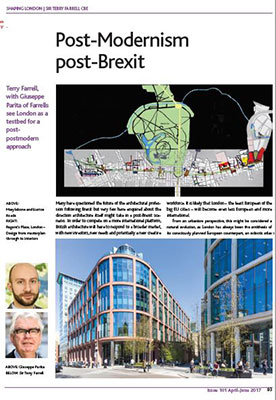

Post-Modernism Post-Brexit
Planning in London April 2017
Many have questioned the future of the architectural profession
following Brexit but very few have enquired about the
direction architecture itself might take in a post-Brexit scenario. Sir Terry and Giuseppe Parita discuss.
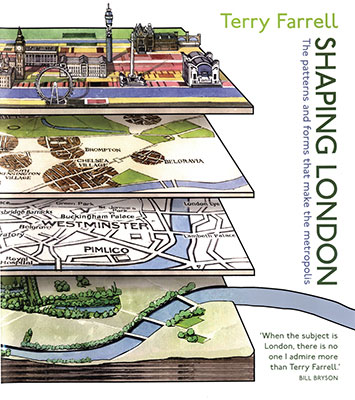

Shaping London
The Patterns and Forms that Make the Metropolis
In this wholly new and dynamic view of London, Sir Terry Farrell looks beyond the contribution of individual buildings to the city. He creates a larger, more exciting frame, charting how the capital’s messy and complex shape has been hewn out of a series of layers – natural and manmade. Illustrated with original sketches, maps, archive photographs and paintings, this book provides a vibrant and intriguing collage of London’s patterns and its history.
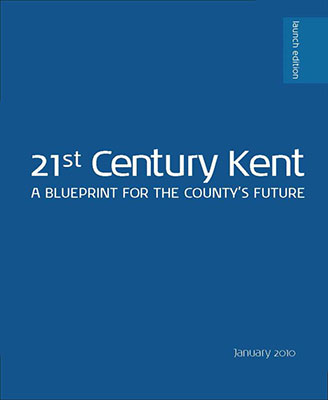

21st Century Kent
A Blueprint for the County's Future
Over the last 30 years Kent has seen major change. Its population has grown by more than 10% from £1.45 million in 1980 to 1.66 million today. Billions of pounds have been invested in the county’s infrastructure including over £5 billion on the UK’s only high speed rail line. Our work builds on Kent’s powerful identity, painting a portrait of how Kent can capitalise on this investment over the next 20 to 30 years. Its aim is to describe a Kent that we are proud to hand over to future generations, one which will be enriched further and developed by constructive dialogue and creative collaboration with Kent’s District and Borough Councils, Medway Council and local communities.
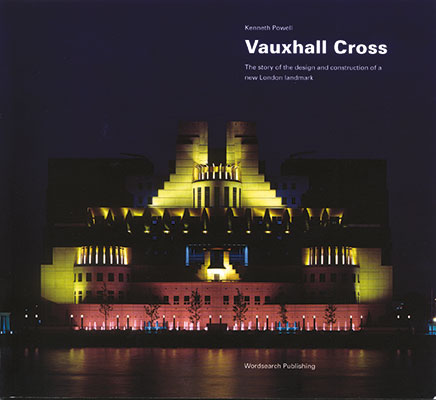

Vauxhall Cross
The Story of the Design and Construction of a New London Landmark
This headquarters building for MI6, on the banks of the River Thames, is an iconic London landmark made famous by the James Bond films. The building is a group of three blocks – low-rise on the river side and medium-rise onto Albert Embankment – which are linked by glazed courtyards and atria. This book tells the story of its design and transformation into an icon.
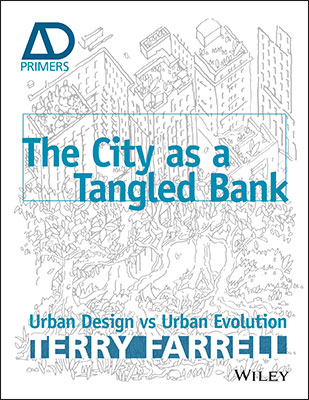

The City as a Tangled Bank
Urban Design vs. Urban Evolution
Here Sir Terry Farrell, who has built an international career as an architect-planner, encourages other planners and architects to follow the biologists—look at, learn from, and, indeed, admire the nature of the forces that drive the change, and then with humility and respect work with them to nudge, anticipate and prepare for where it takes us. Farrell brings his considerable experience in practice to bear, elucidating his thoughts with examples from cities across the world, including Beijing, Hong Kong, London, New York, and Paris.
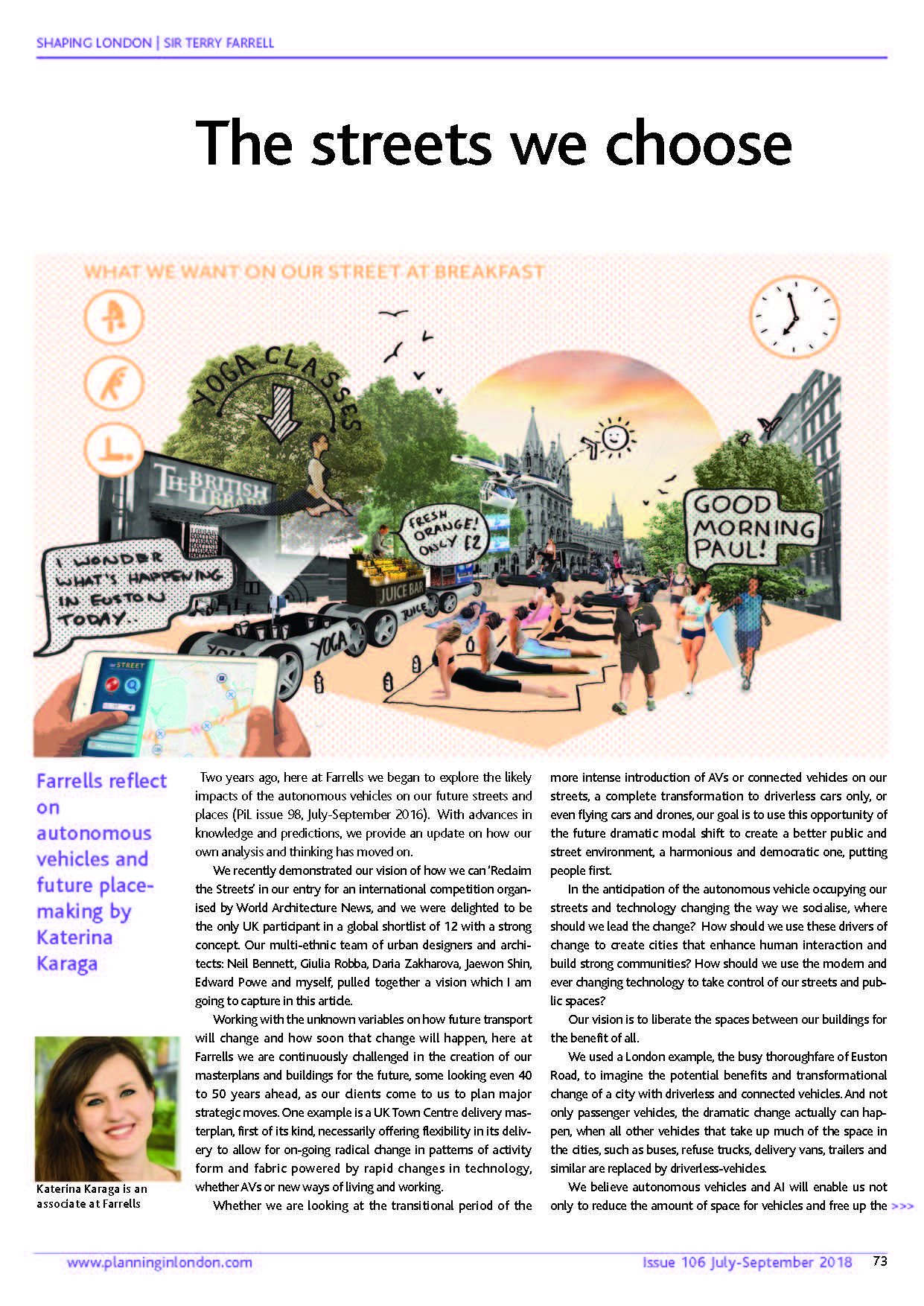

The Streets We Choose
Planning in London July 2018
Two years ago, here at Farrells we began to explore the likely
impacts of the autonomous vehicles on our future streets and
places (PiL issue 98, July-September 2016). With advances in
knowledge and predictions, we provide an update on how our
own analysis and thinking has moved on.
We recently demonstrated our vision of how we can ‘Reclaim
the Streets’ in our entry for an international competition organised
by World Architecture News, and we were delighted to be
the only UK participant in a global shortlist of 12 with a strong
concept. Our multi-ethnic team of urban designers and architects:
Neil Bennett, Giulia Robba, Daria Zakharova, Jaewon Shin,
Edward Powe and myself, pulled together a vision which I am
going to capture in this article.
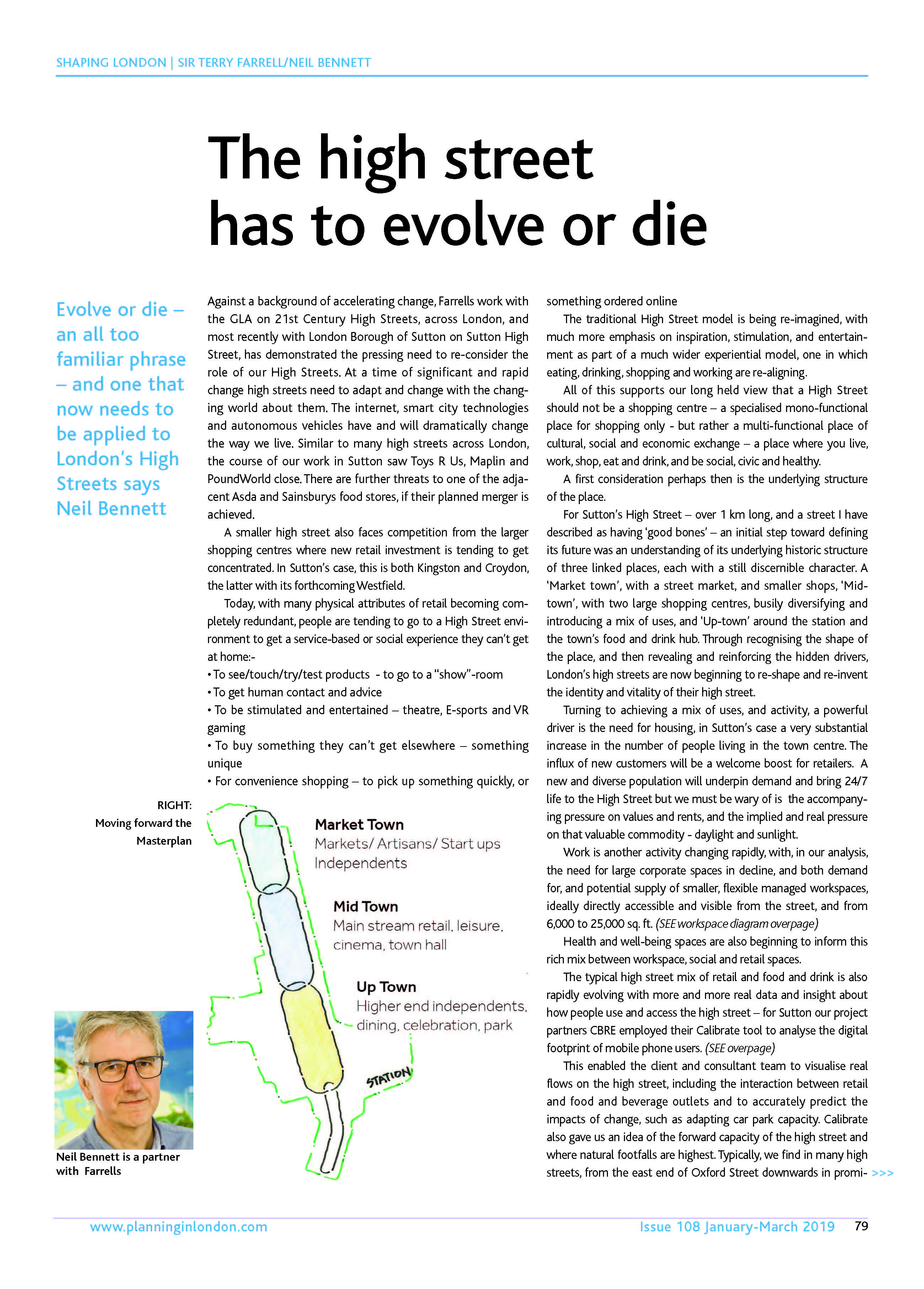

The high street has to evolve or die
Planning in London January 2019
Against a background of accelerating change, Farrells work with the GLA on 21st Century High Streets, across London, and most recently with London Borough of Sutton on Sutton High Street, has demonstrated the pressing need to re-consider the role of our High Streets. At a time of significant and rapid change high streets need to adapt and change with the chang-ing world about them. The internet, smart city technologies and autonomous vehicles have and will dramatically change the way we live. Similar to many high streets across London, the course of our work in Sutton saw Toys R Us, Maplin and PoundWorld close. There are further threats to one of the adja-cent Asda and Sainsburys food stores, if their planned merger is achieved. A smaller high street also faces competition from the larger shopping centres where new retail investment is tending to get concentrated. In Sutton’s case, this is both Kingston and Croydon, the latter with its forthcoming Westfield.
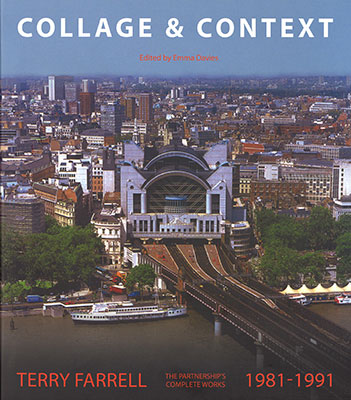

Collage & Context
The work of Terry Farrell & Partners 1981-1991
Collage & Context covers the 1980s, when the practice was founded, and features the work that established Terry Farrell’s reputation. It includes such seminal projects as Clifton Nurseries, the TVam building, Charing Cross and the MI6 building.
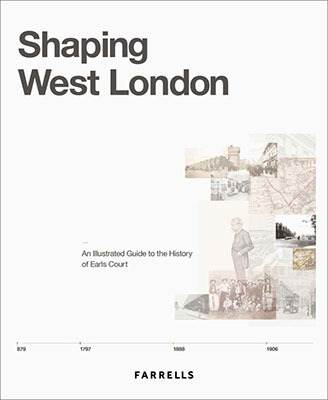

Shaping West London
An Illustrated Guide to the History of Earls Court
As part of our work on Earls Court, we have carefully studied the area’s history in order to come to terms with this complex and fascinating part of London.
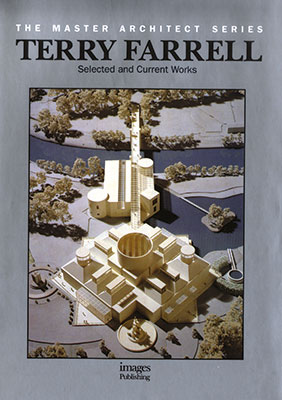

Terry Farrell: Selected and Current Works
The Master Architect Series
The Master Architect Series is a series of monographs on some of the greatest architects and architectural firms of our time.
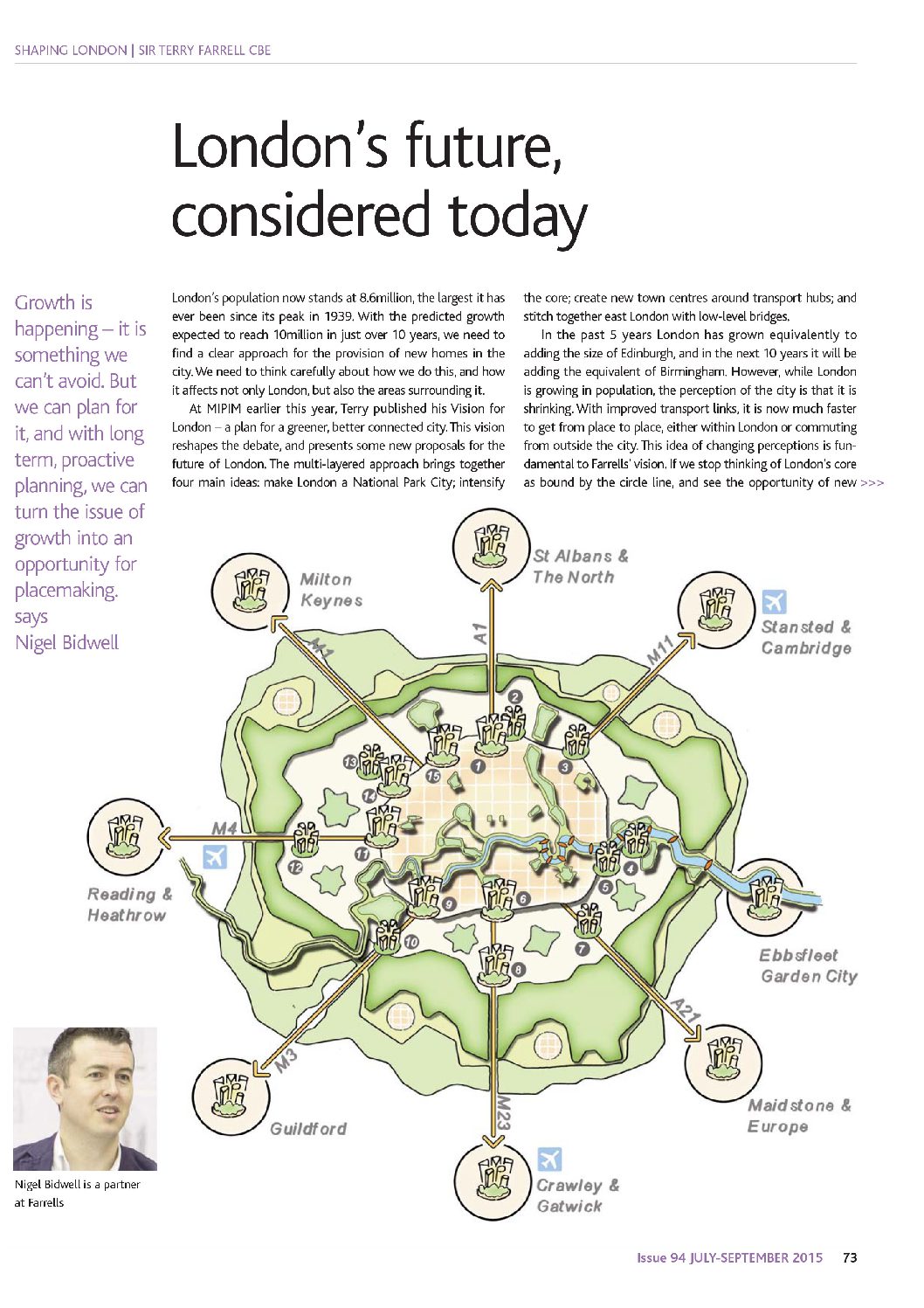

London’s future considered today
Planning in London July 2015
Growth is happening – it is something we can’t avoid. But we can plan for it, and with long term, proactive planning, we can turn the issue of growth into an opportunity for placemaking says Farrells Partner Nigel Bidwell.
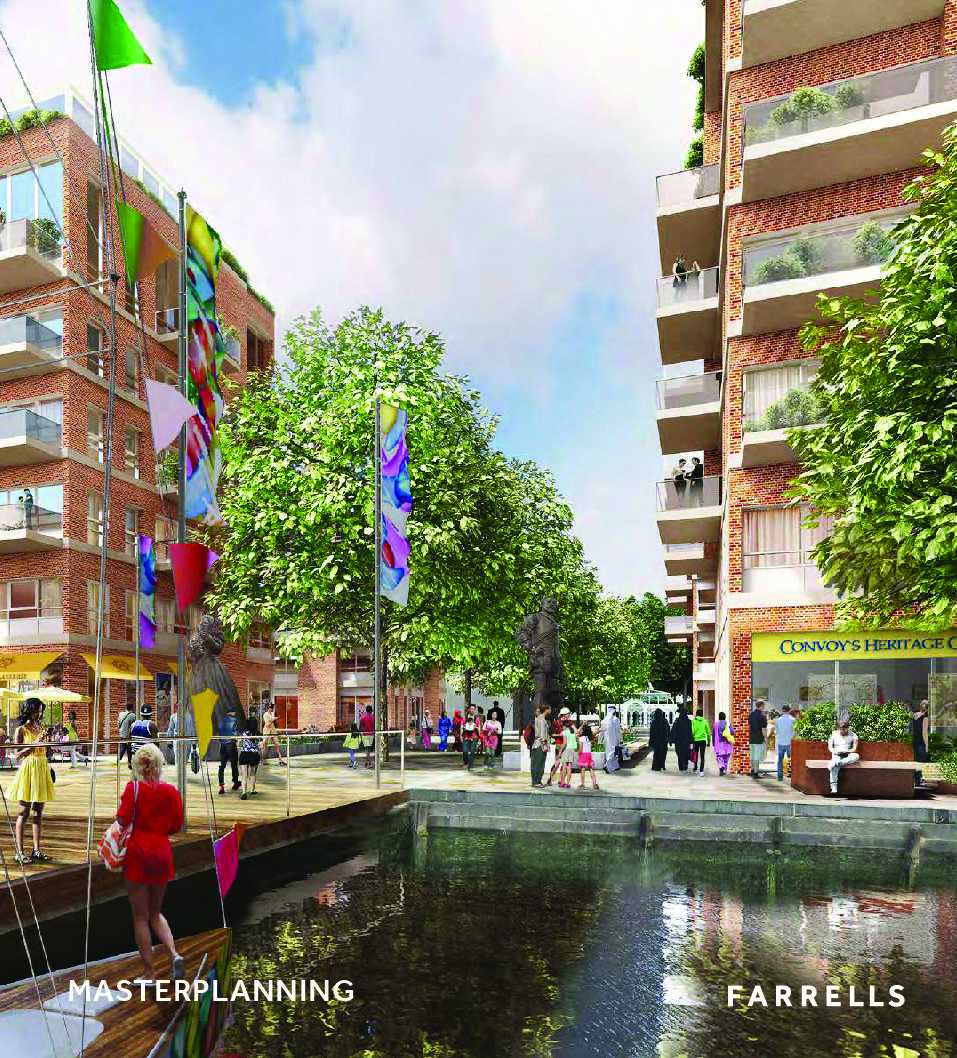

Farrells Masterplanning Projects
Farrells London
For over fifty years, Farrells has championed place-making, the public realm and world-class masterplanning, leading to the government commissioned Farrell Review of architecture. Our unique collaborative design process results in places where landscape is the first infrastructure. We are acknowledged as the country’s leading architect planners, implementing truly mixed-use environments with high quality public realm, always creating memorable places that people want to live, work and play in.
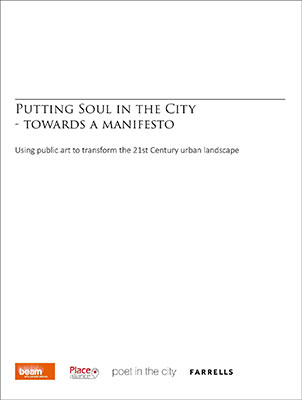

Putting Soul in the City – Towards a Manifesto
Using public art to transform the 21st Century urban landscape
Working with Beam, Poet in the City and the Place Alliance, we looked into the role of art in place-making and urban development, as advocated in the Farrell Review.
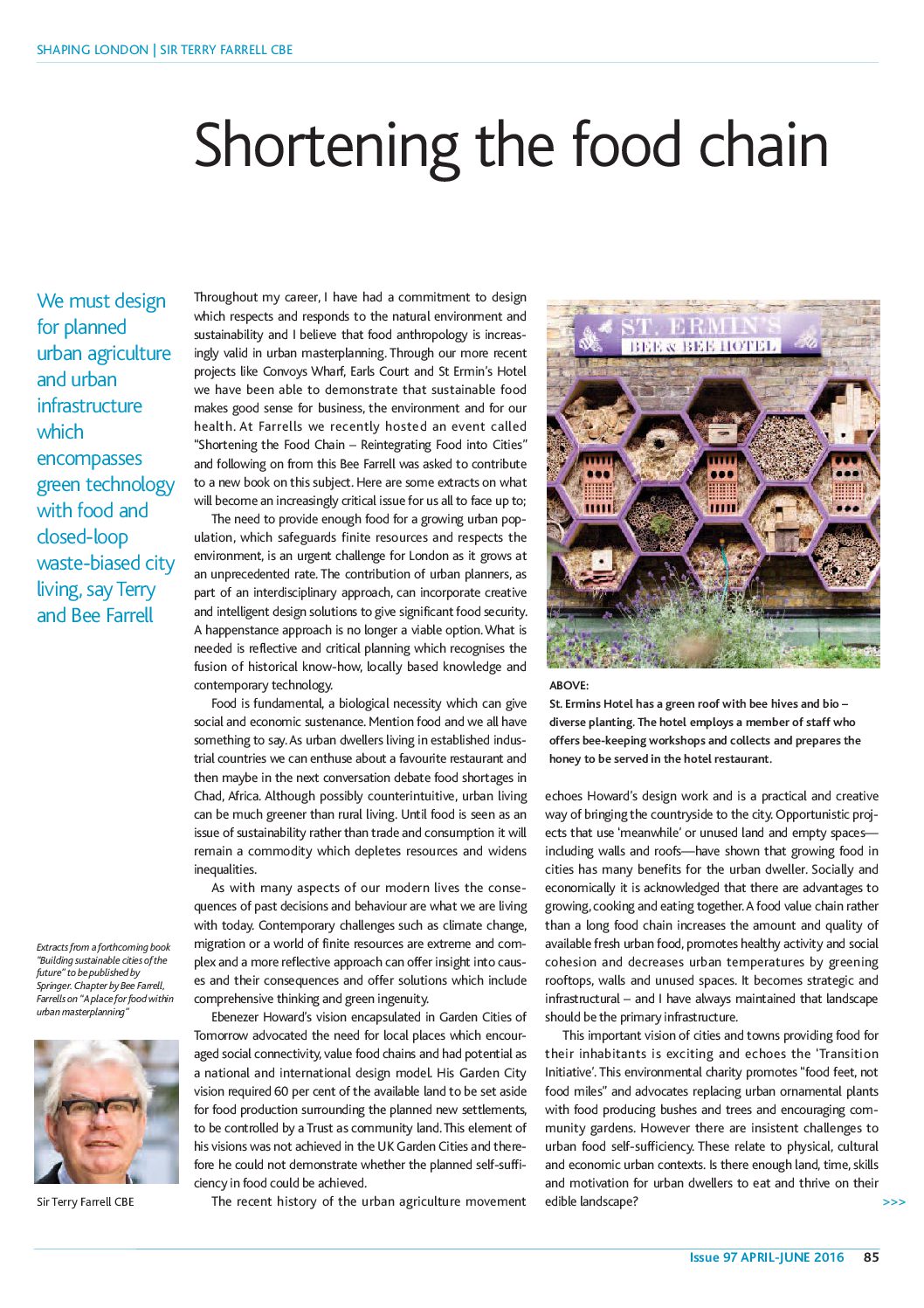

Shortening the food chain
Planning in London April 2016
We must design for planned urban agriculture and urban infrastructure which encompasses green technology with food and closed-loop waste-biased city living, say Terry and Bee Farrell.
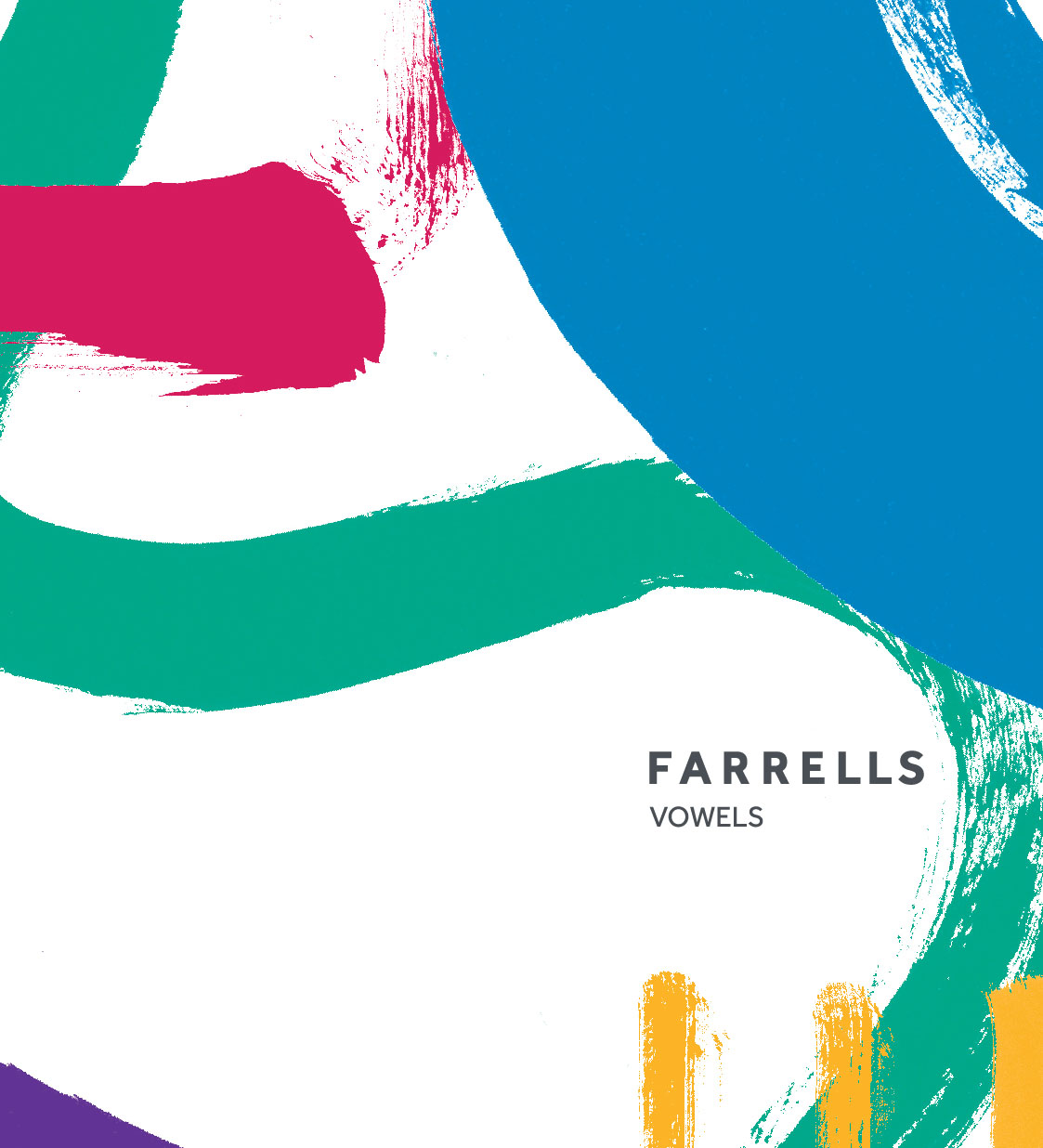

VOWELS
Vowels are special letters that help build a word and render the way we pronounce it. Similarly in architecture, there are common design traits that exude certain visions, connect and stimulate particular mental associations, influence the way we register shapes, and change the way we experience architecture.
This book captures the studio’s pursuit of innovative, social-minded, and transformative design. We honed in on five broad architectural components – Arcs, Triangles, Oblongs, Waves, and Blades – using a selection of sketches, process renderings, and photography to reflect on our work from new angles.
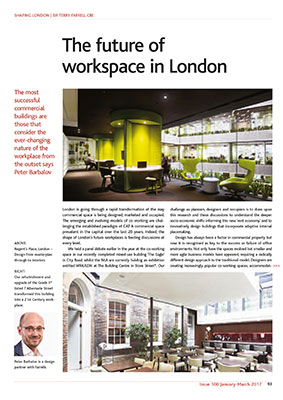

The future of workspace in London
Planning in London January 2017
The most successful commercial buildings are those that consider the ever- changing nature of the workplace from the outset says Farrells Partner Peter Barbalov.
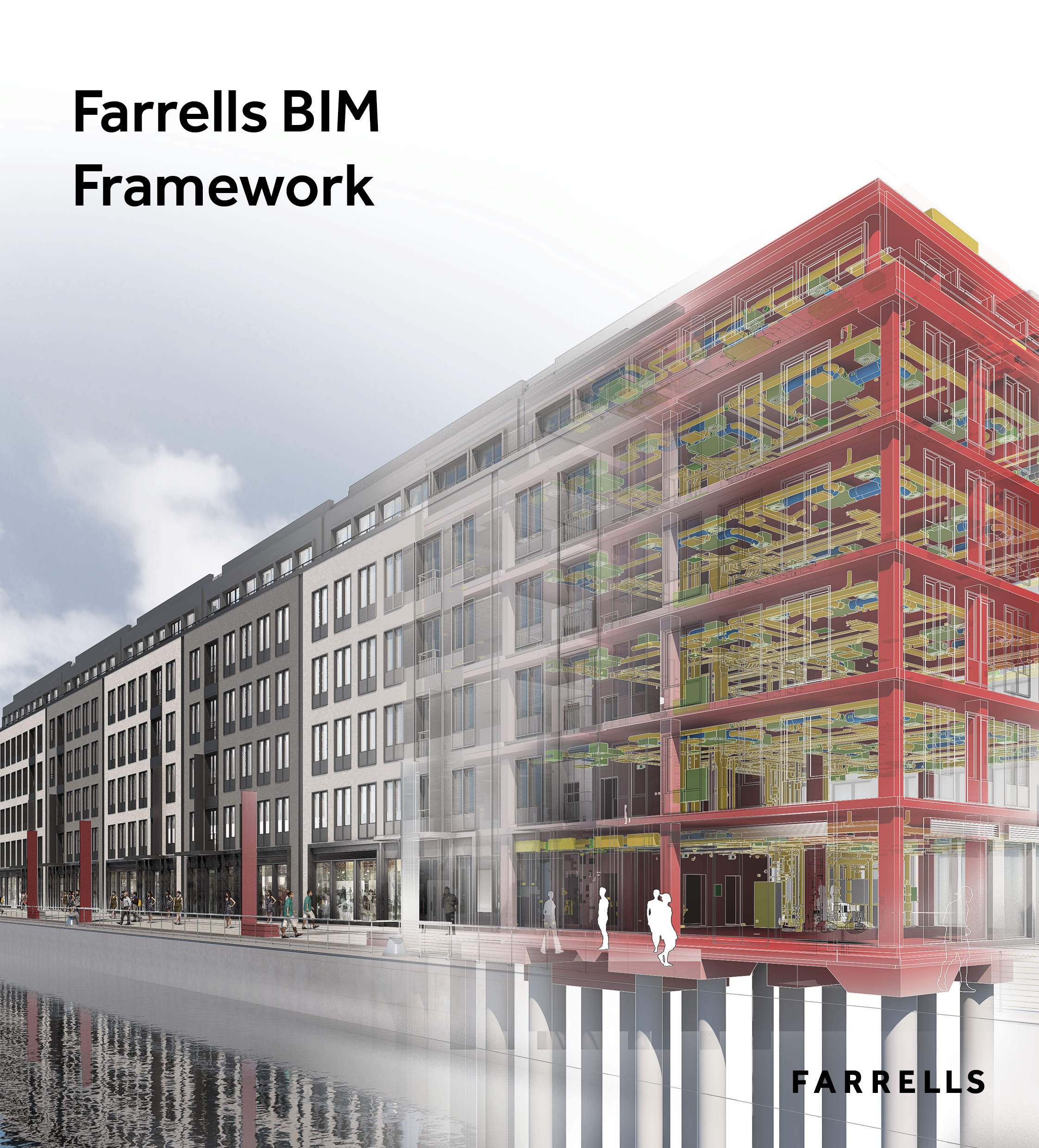

Farrells BIM Framework
Building Information Modelling (BIM)
At Farrells we have adopted Building Information Modelling (BIM) in a variety of projects across the practice to facilitate more efficient collaboration, co-ordination, and delivery between consultants at all work stages.
To ensure maximum collaboration and integration of work with the consultant team, Farrells have implemented several processes standards and process for all BIM projects. We have an in-house core BIM team led by a BIM Accredited Professional Manager with an accreditation from BRE who is responsible for BIM standards development, implementation and enforcement and supporting project standards coordination with clients.
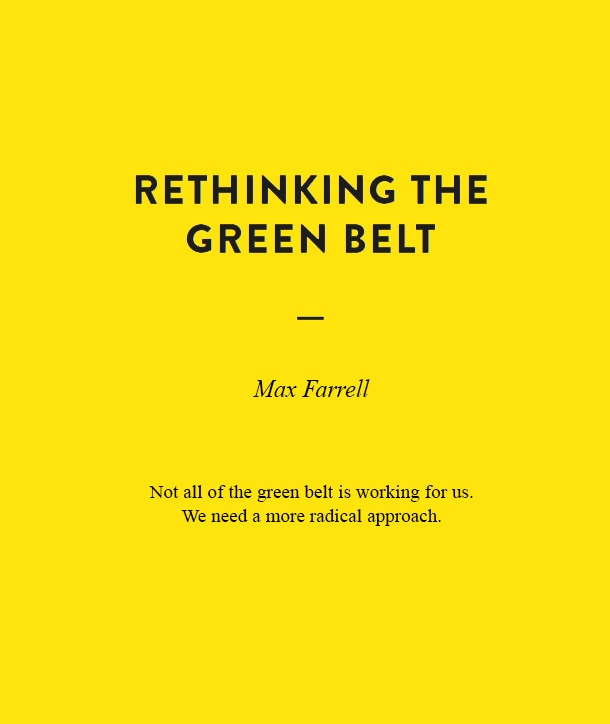

Rethinking The Greenbelt
London Essays: Issue 8 Futures
“Not all of the green belt is working for us. We need a more radical approach,” argues Max Farrell in the eighth issue of London Essays, titled “Futures.”
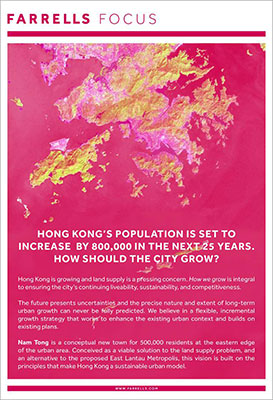

Farrells Focus – Nam Tong
Farrells Hong Kong
Hong Kong is growing and land supply is a pressing concern. How we grow is integral to ensuring the city’s continuing liveability, sustainability, and competitiveness.
The future presents uncertainties and the precise nature and extent of long-term urban growth can never be fully predicted. We believe in a flexible, incremental growth strategy that works to enhance the existing urban context and builds on existing plans.
Nam Tong is a conceptual new town for 500,000 residents at the eastern edge of the urban area.
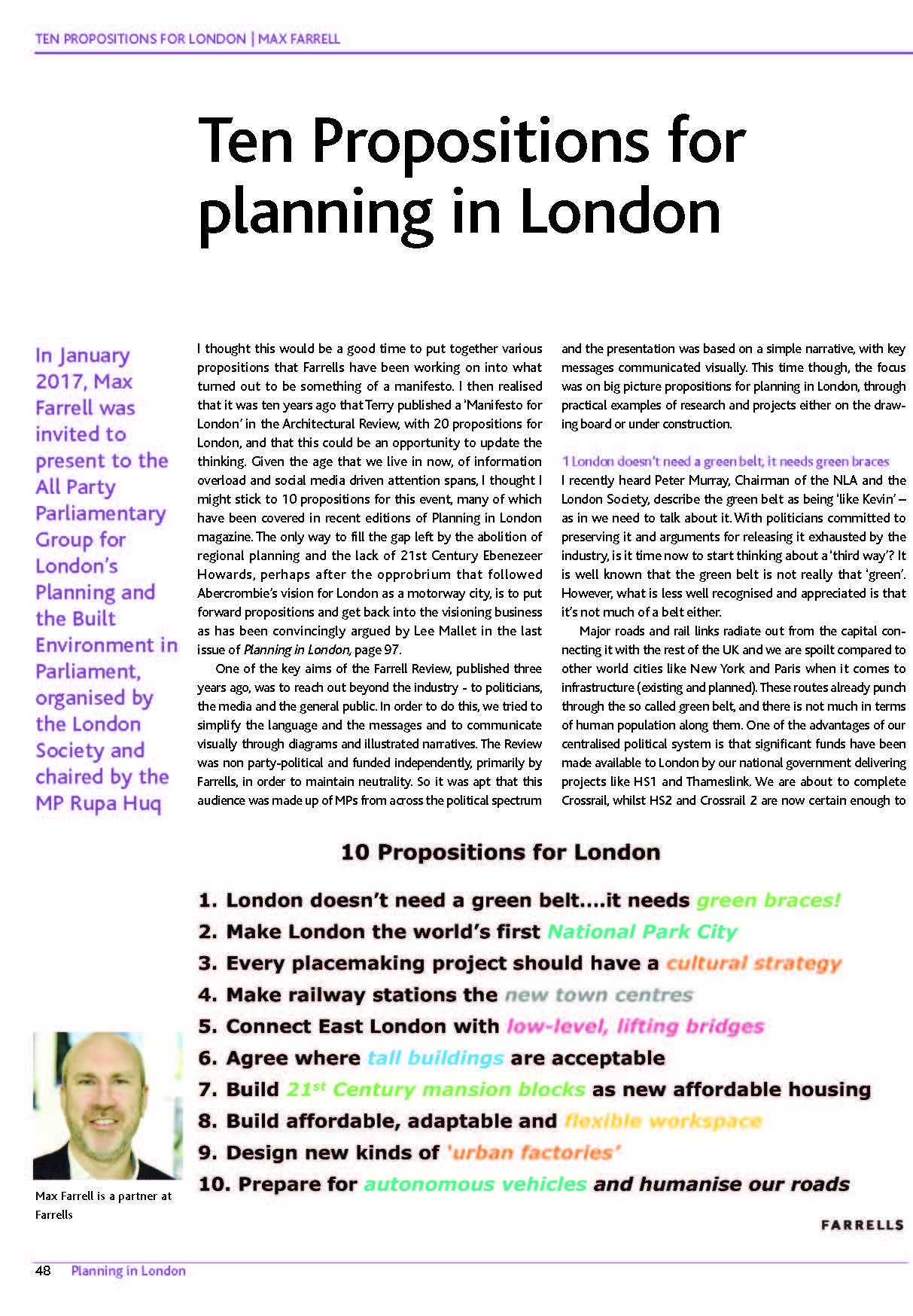

Ten Propositions for Planning in London
Planning in London April 2017
In January 2017, Max Farrell was invited to present to the All Party Parliamentary Group for London’s Planning and the Built Environment in Parliament, organised by the London Society and chaired by the MP Rupa Huq. Here’s what he said to them…


Twenty-Five Years in China
Exhibition Summary
To celebrate the 25th anniversary of Farrells in China, a travelling architectural exhibition named Urban Dialogue began in Hong Kong, hosted later in Beijing, Shanghai and in October 2017 in Singapore.
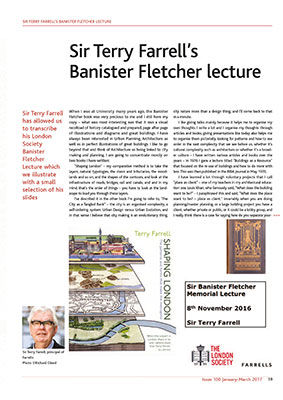

Sir Terry Farrell’s Banister Fletcher lecture
Planning in London January 2017
A transcription of Sir Terry’s 2016 London Society Banister Fletcher Lecture.
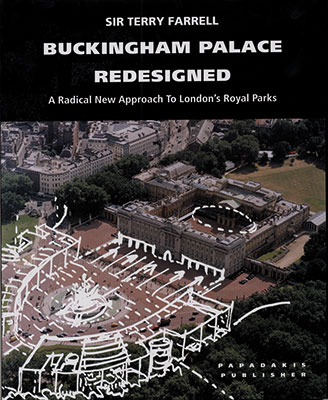

Buckingham Palace Redesigned
A Radical New Approach to London's Royal Parks
London’s royal parks and palaces play a vital role: they highlight the difference between the City of Westminster and the City of London, or the seat of government and monarchy, and the seat of commerce.
The primary motivation for drawing up these concepts on Buckingham Palace arises from the long-held belief that the Royal Parks and palaces are London’s primary public realm and virtually the only world-class public realm in the urban metropolis of this great capital city.
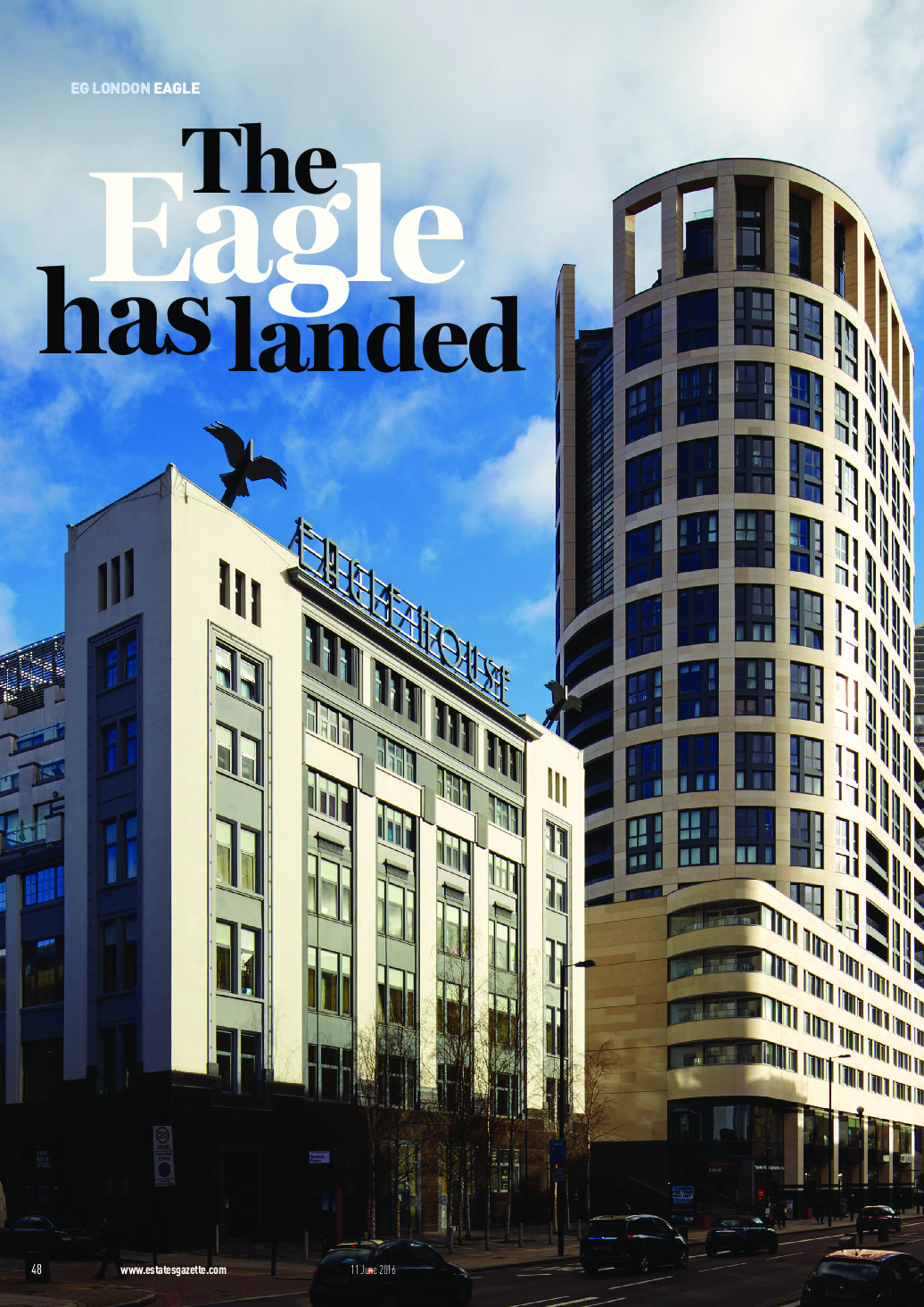

The Eagle has landed
Estates Gazette London
“In Art Deco style, reflecting the original 1930s building, it punctuates the Old Street grime while mirroring the colours and hues of some of the area’s more traditional stock, such as the iconic Moorfields Eye Hospital. It stands out yet somehow also fits right in.” Janie Manzoori-Stamford reports on the completion of The Eagle, London in 2016.
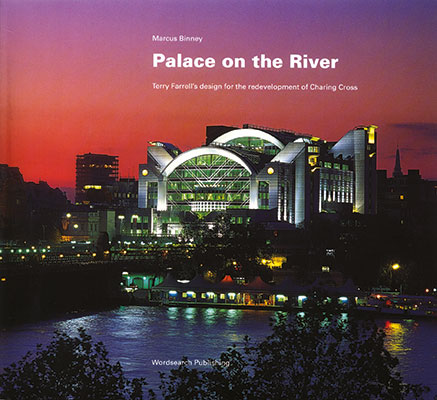

Palace on the River
Terry Farrell's Design for the Redevelopment of Charing Cross
The primary development at Embankment Place was a new office building occupying the air-rights space above Charing Cross Station. It was technologically innovative, involving the suspension of nine storeys of offices above the railway tracks, isolating the space from railway vibration. The resulting bowstring arch over the tracks, supported on 18 columns rising through the platforms, framed a new waterfront landmark at this prominent point on the River Thames. This book tells the story of its design and transformation into a landmark on the river Thames.


Farrells 2015 Vision for London
Sir Terry Farrell reveals his new London masterplan
London’s future success will depend on bold and innovative planning on a city-wide scale. Architect Sir Terry Farrell talks Emily Wright through his new vision for the capital
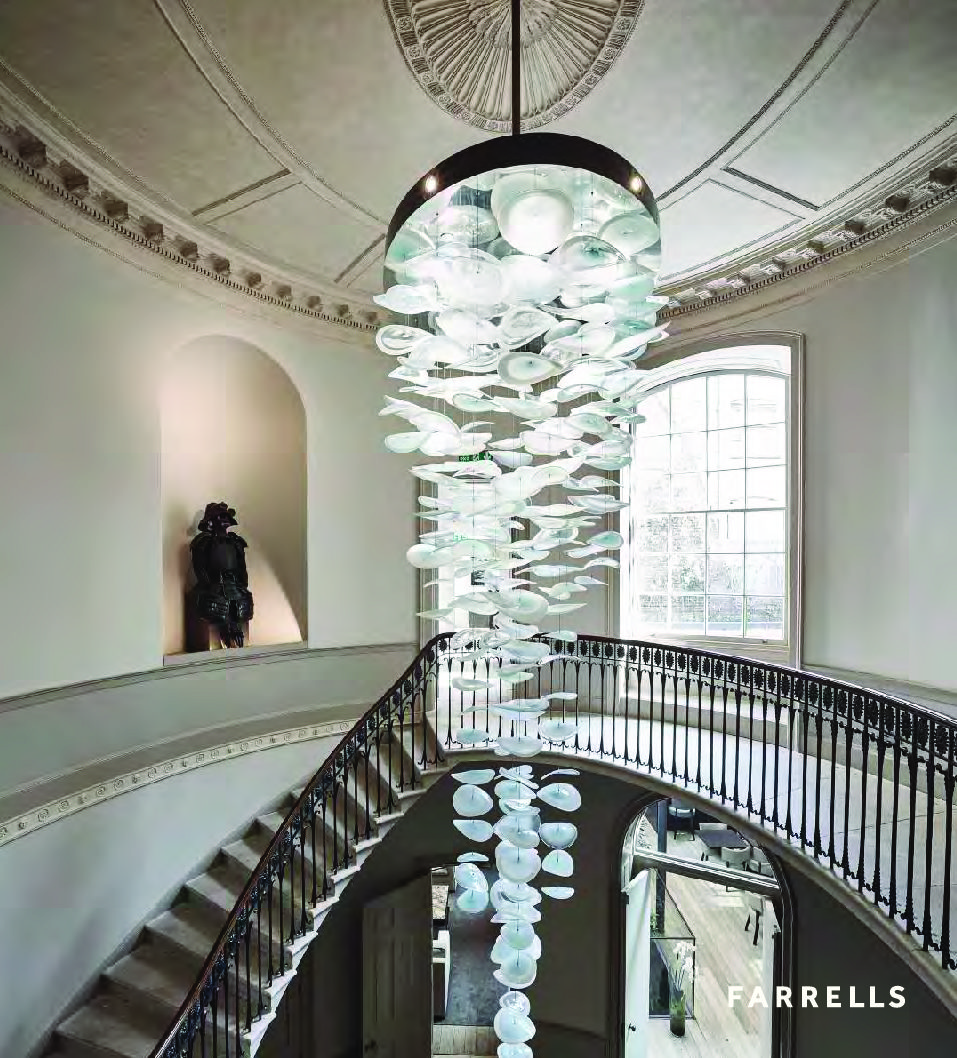

Farrells Projects
Farrells London
Farrells are internationally recognised architects & urban designers. We have designed award-winning buildings and masterplans throughout the world for over half a century. Our specialism is high quality, mixed-use urban complexes, often based around transport interchanges. We are responsive, imaginative and skilled in design and have a passion for environmental sustainability, using resources wisely and creating resilient communities.
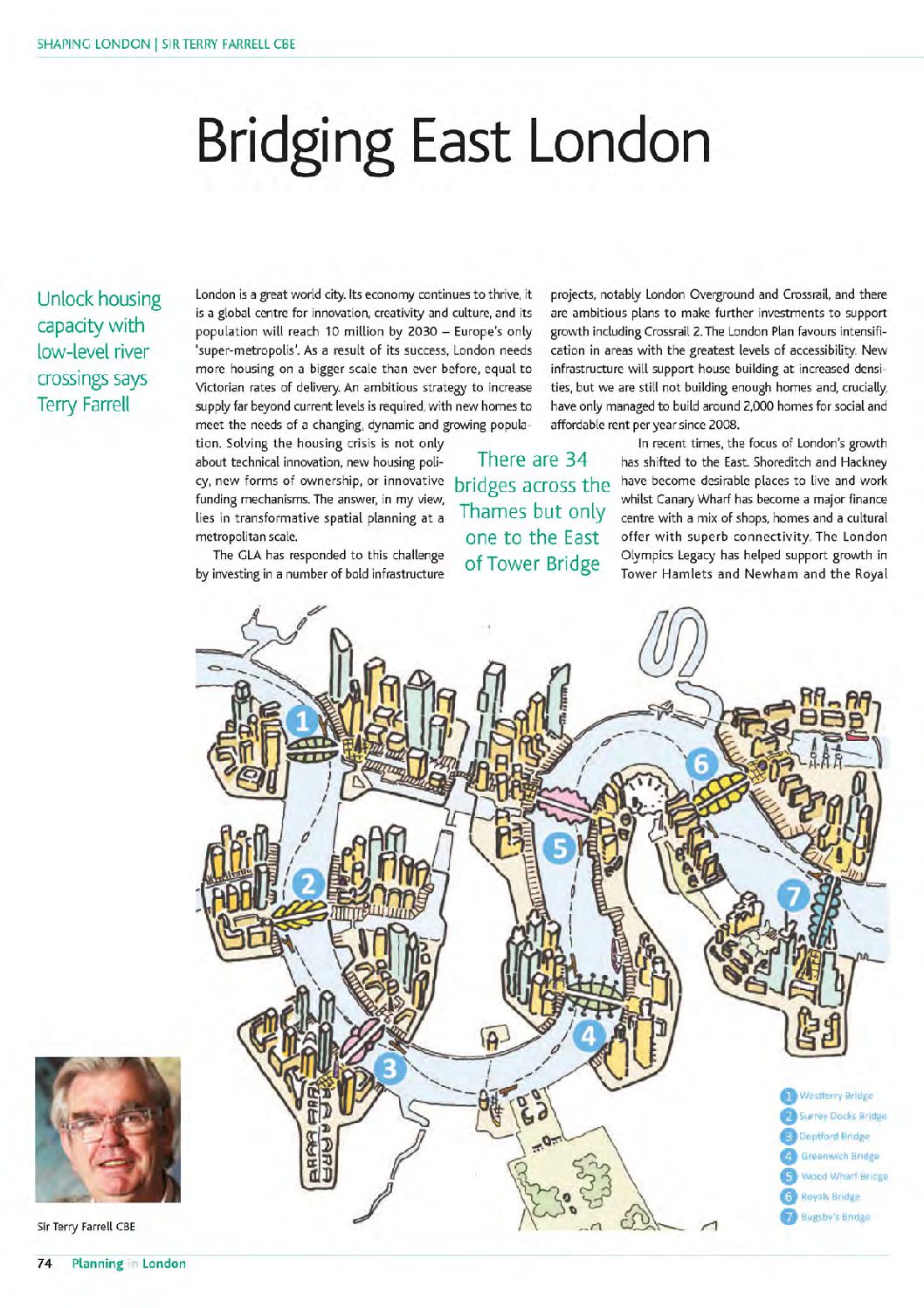

Bridging East London
Planning in London October 2015
There are 34 bridges across the Thames but only one to the East of Tower Bridge – Sir Terry discusses the need to unlock housing capacity with low-level river crossings.
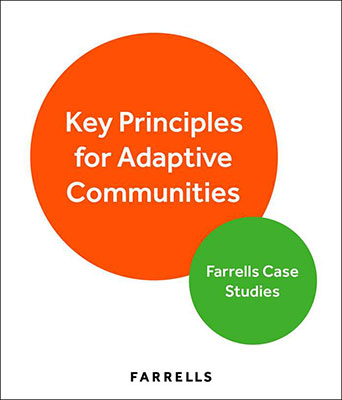

Key Principles for Adaptive Communities
Farrells Case Studies
Farrels are committed to sustainable urbanism and have put together a set of key principles to create adaptive communities, using our projects as case studies.
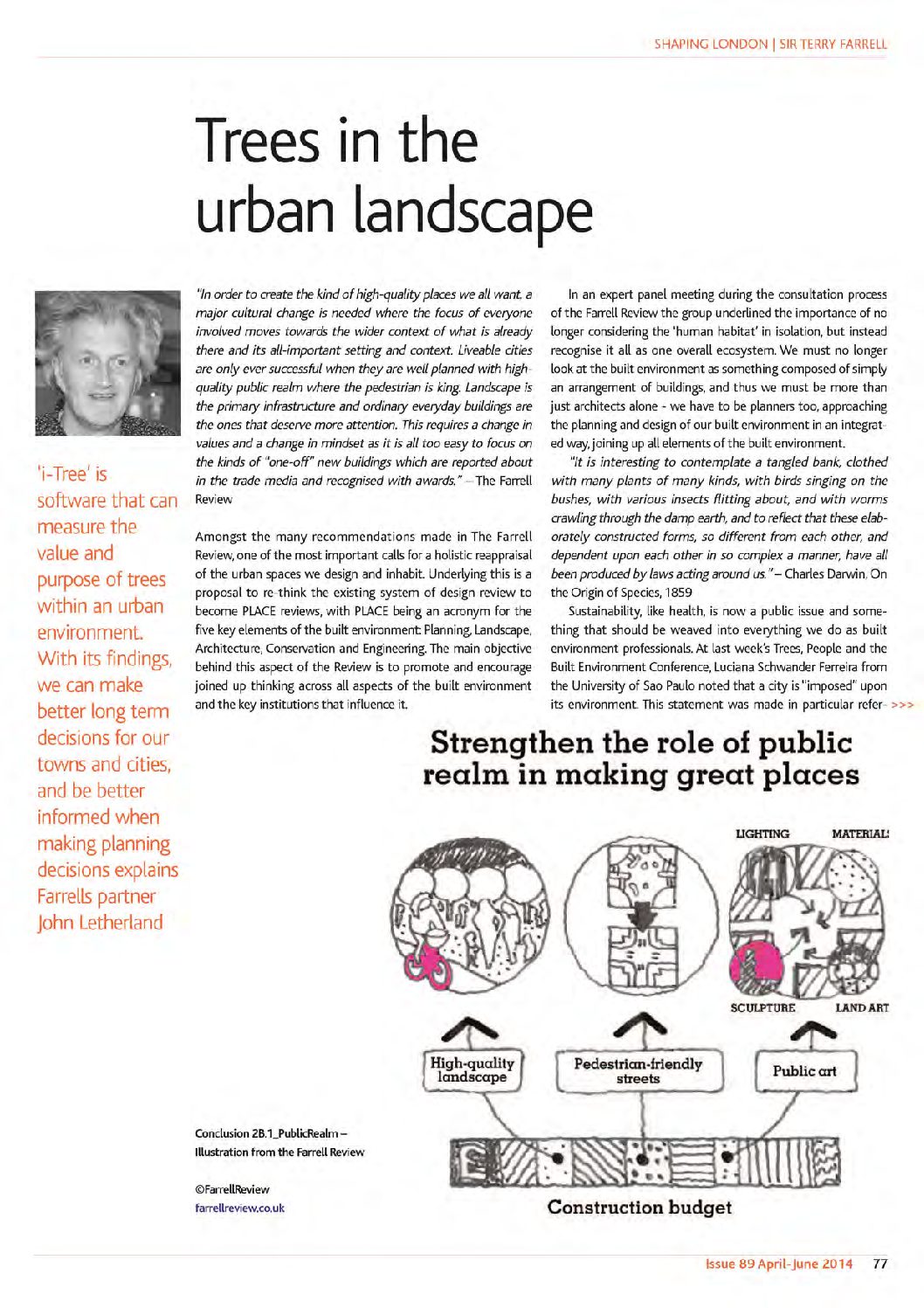

Trees in the Urban Landscape
Planning in London April 2014
“Trees simply make our towns and cities a better place to be, as well as bringing health, food, oxygen, fuel, environmental and climatic benefits as well as sustenance and habitats for other species.”
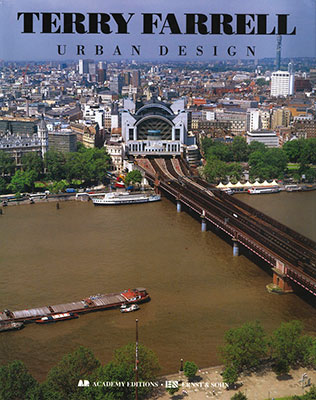

Terry Farrell
Urban Design
Urban design should be based on a number of principles: a notion of continuum with the history and traditions of a specific area, a priority given to the pedestrian and the experience of the street and a desire to create new places with an identity to encourage the return of the diversity of traditional urban life. Each chapter of this illustrated book presents a series of projects within London.
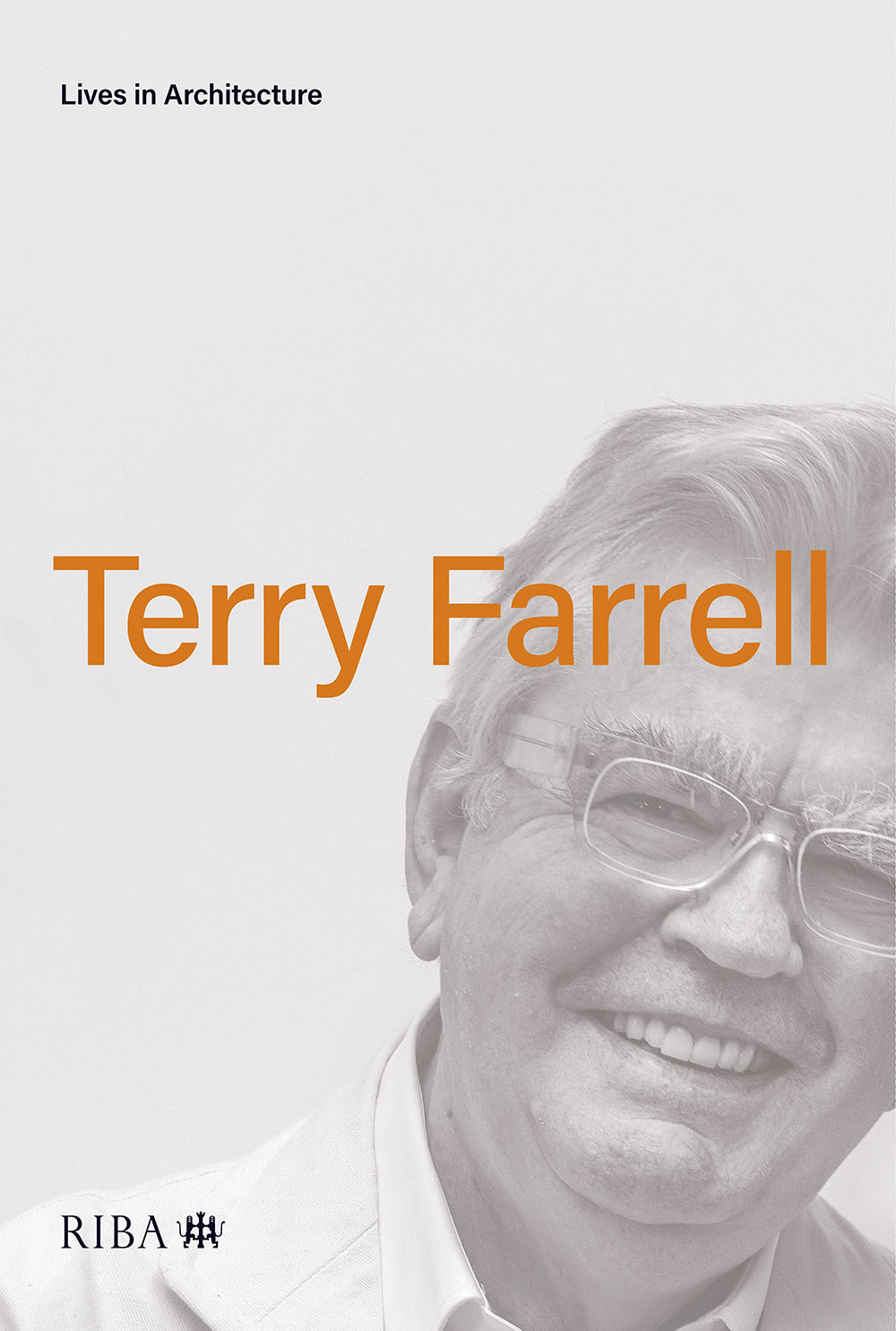

Lives in Architecture
Terry Farrell
Lives in Architecture offers the inside view of what it is like to be an architect at the top of his profession, including insights into the defining projects and watershed moments of Sir Terry Farrell’s career. This book also provides the inside story on some of Terry Farrell’s most significant buildings and projects, including Charing Cross Station, The MI6 Building, Alban Gate and Beijing South Railway Station, abundantly illustrated with over 80 images, including personal photos and images of key buildings.
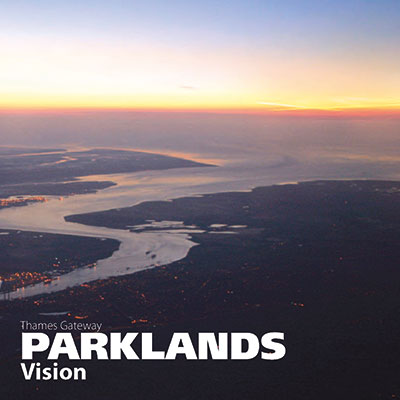

Thames Gateway Parklands Vision
In collaboration with the Department for Communities and Local Government
This document sets out an aspirational vision, which will guide and support improvements to the environment and define Parklands’ contribution to the UK’s first ‘eco-region’ in the Thames Gateway.
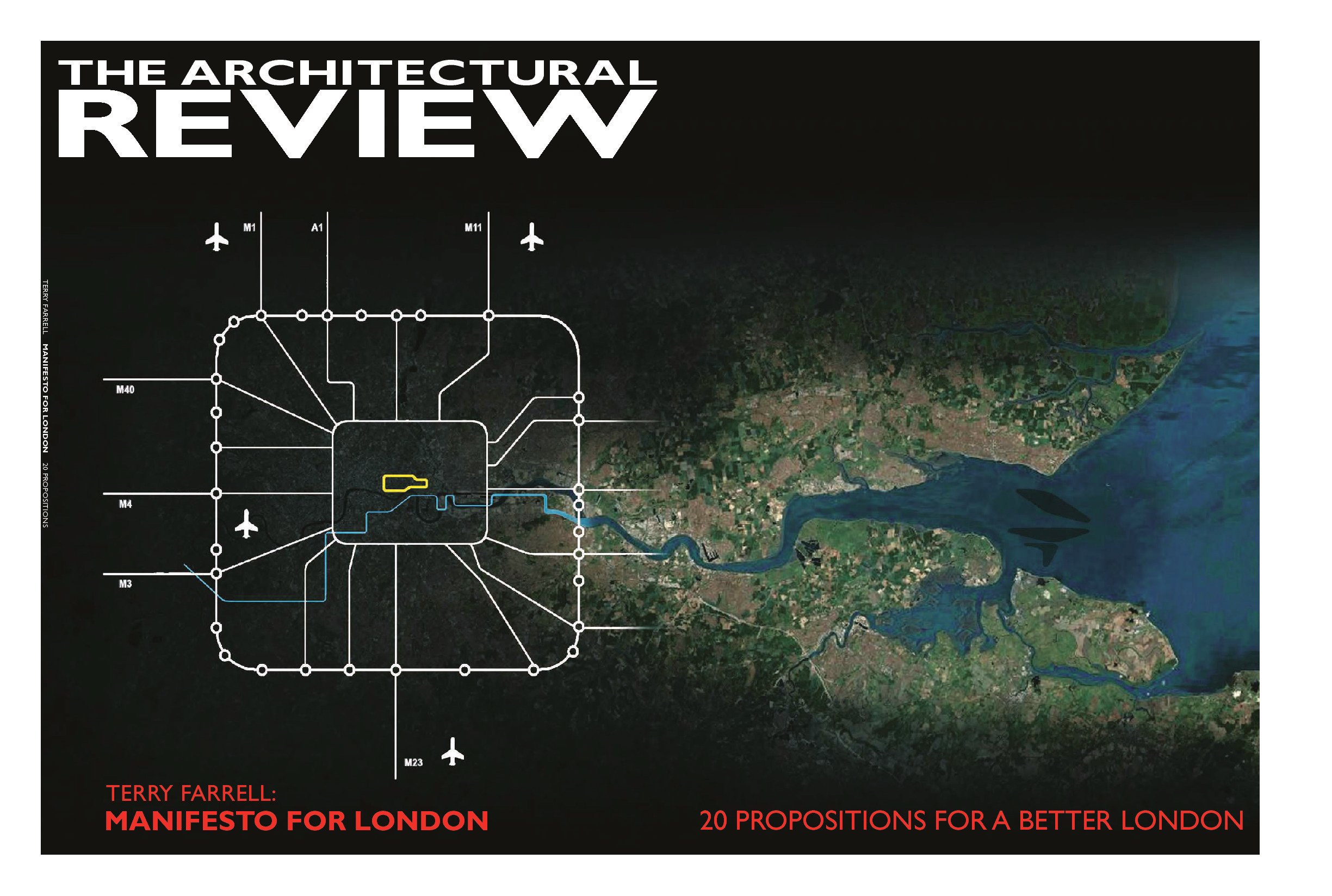

Terry Farrell: Manifesto for London
20 Propositions for a Better London
Introducing this special issue of the Architectural Review on London, Terry Farrell considers the dynamic, intricate and rapidly evolving nature of the metropolis and how propositions for urban planning must respond to its unique spirit of place.
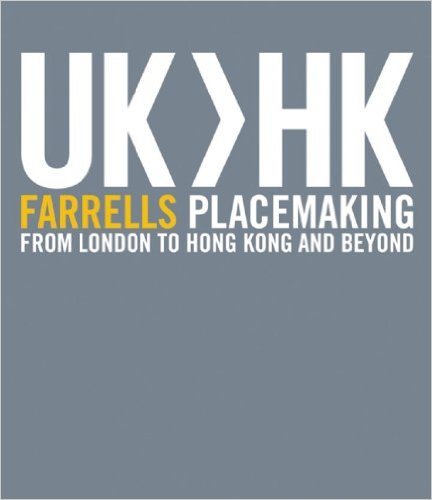

UK>HK Farrells Placemaking
From London to Hong Kong and Beyond
Since establishing a foothold in Hong Kong in early 1990, Farrells have gone on to design and construct place-making buildings and railway related projects throughout the Asia-Pacific region. A collection of these projects are presented here, photographed in full colour, and accompanied by plans, elevations, diagrams and explanatory texts.


Sketchbook
12.05.98
Documenting a time of intense creative energy in one of the world’s busiest architectural offices. This snapshot of work comprises evocative drawings, models and collages, ranging from first concepts through explanatory investigations to presentation images. By showing the way in which ideas are elaborated, explored and developed, it offers a unique insight into the creative processes of the architect.
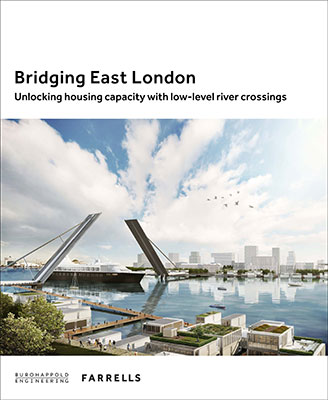

Bridging East London
Unlocking housing capacity with low-level river crossings
Working with Burohappold, Farrells have carried out research into the need for river crossings in East London. This is a summary of that work. Awarded the 2015 London Planning Awards for Best Conceptual Project, the call for more low-level river crossings east of Tower Bridge is more relevant than ever.
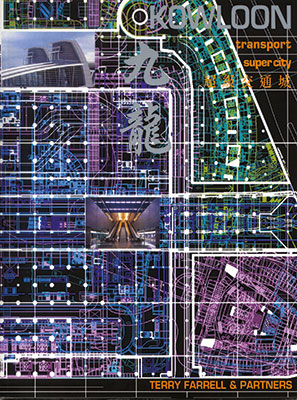

Kowloon
Transport Super City
The book celebrates Kowloon Station – a demanding project which integrates architecture, transportation and urban development.
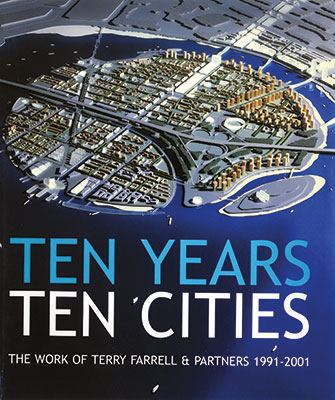

Ten Years Ten Cities
The Work of Terry Farrell and Partners 1991-2001
Ten Years Ten Cities covers projects between 1991-2001; each chapter is devoted to a city where we have worked on a large-scale project.
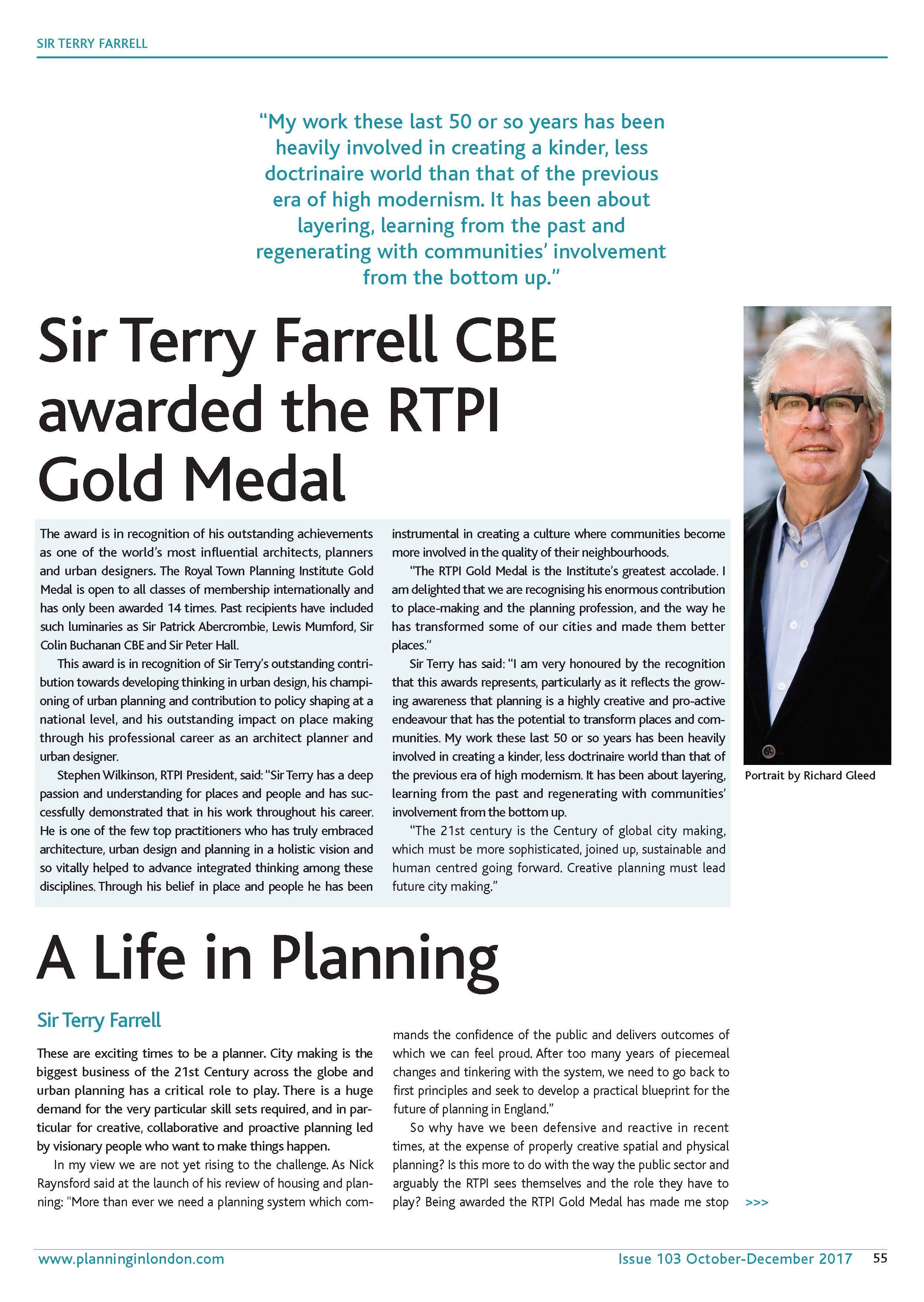

A Life in Planning
Planning in London October 2017
“These are exciting times to be a planner. City making is the biggest business of the 21st Century across the globe and urban planning has a critical role to play. There is a huge demand for the very particular skill sets required, and in particular for creative, collaborative and proactive planning led by visionary people who want to make things happen.
In my view we are not yet rising to the challenge.”
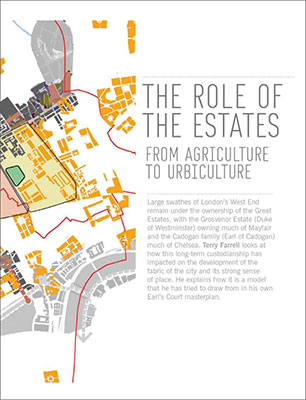

The Role of the Estates
From Agriculture to Urbiculture
Sir Terry looks at how this long-term custodianship has impacted on the development of the fabric of the city and its strong sense of place, explaining how it is a model that we have tried to draw from in our Earl’s Court masterplan.
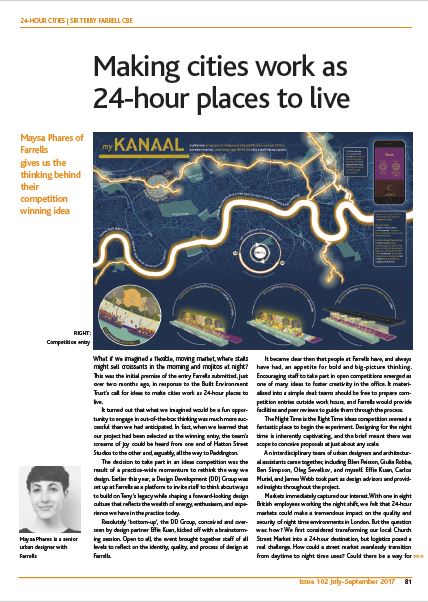

Making Cities Work as 24-hour Places to Live
Planning in London July 2017
What if we imagined a flexible, moving market, where stalls
might sell croissants in the morning and mojitos at night?
This was the initial premise of the entry Farrells submitted, just
over two months ago, in response to the Built Environment
Trust’s call for ideas to make cities work as 24-hour places to
live.
It turned out that what we imagined would be a fun opportunity
to engage in out-of-the-box thinking was much more successful
than we had anticipated. In fact, when we learned that
our project had been selected as the winning entry, the team’s
screams of joy could be heard from one end of Hatton Street
Studios to the other and, arguably, all the way to Paddington.
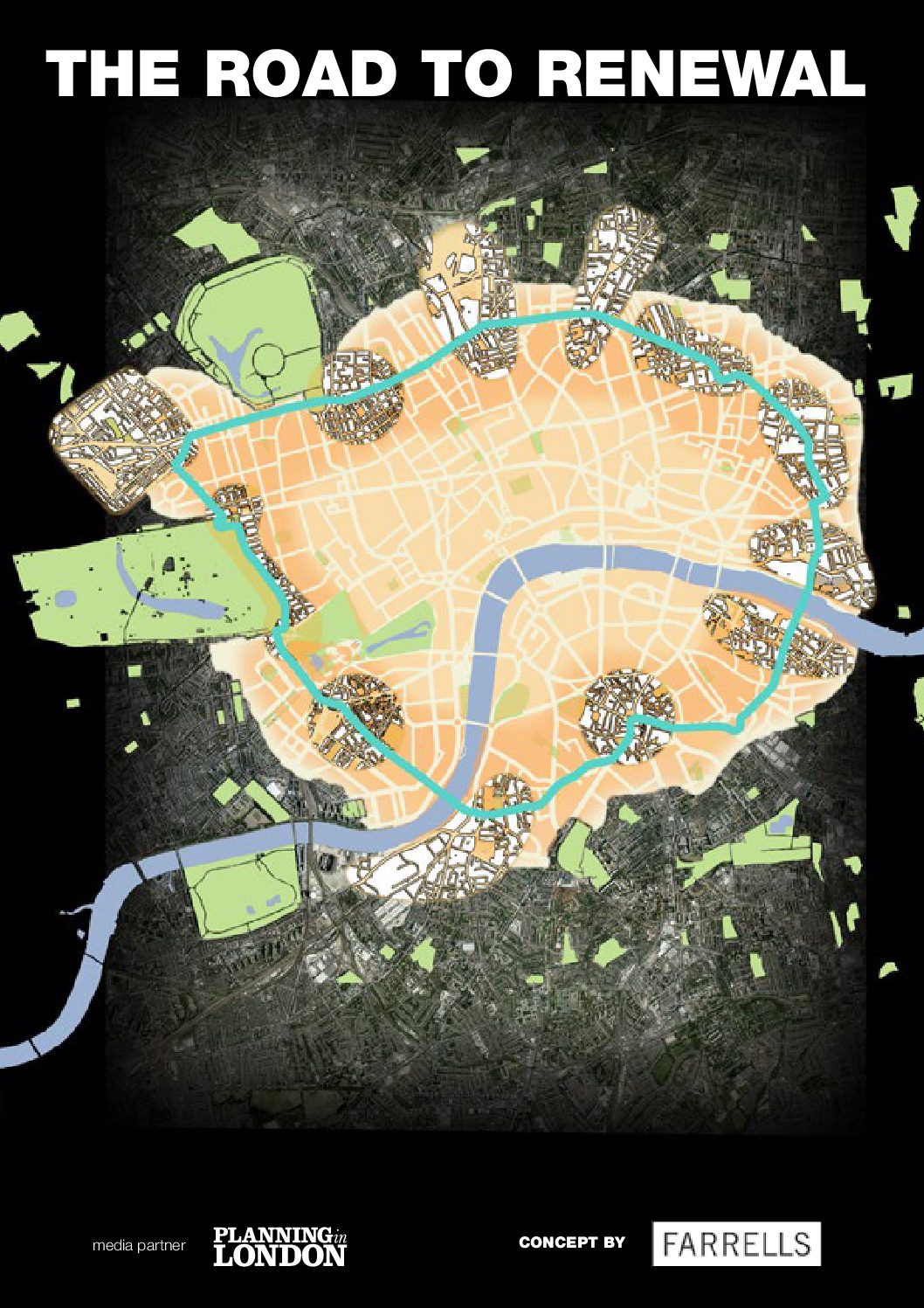

The Road to Renewal
Taming the Urban Motorway
“We must reclaim London’s Inner Ring Road and make new pedestrian places” – a look into London’s central road networks and the expansion of the central core.


The Streets We Choose
Planning in London July 2018
Two years ago, here at Farrells we began to explore the likely
impacts of the autonomous vehicles on our future streets and
places (PiL issue 98, July-September 2016). With advances in
knowledge and predictions, we provide an update on how our
own analysis and thinking has moved on.
We recently demonstrated our vision of how we can ‘Reclaim
the Streets’ in our entry for an international competition organised
by World Architecture News, and we were delighted to be
the only UK participant in a global shortlist of 12 with a strong
concept. Our multi-ethnic team of urban designers and architects:
Neil Bennett, Giulia Robba, Daria Zakharova, Jaewon Shin,
Edward Powe and myself, pulled together a vision which I am
going to capture in this article.
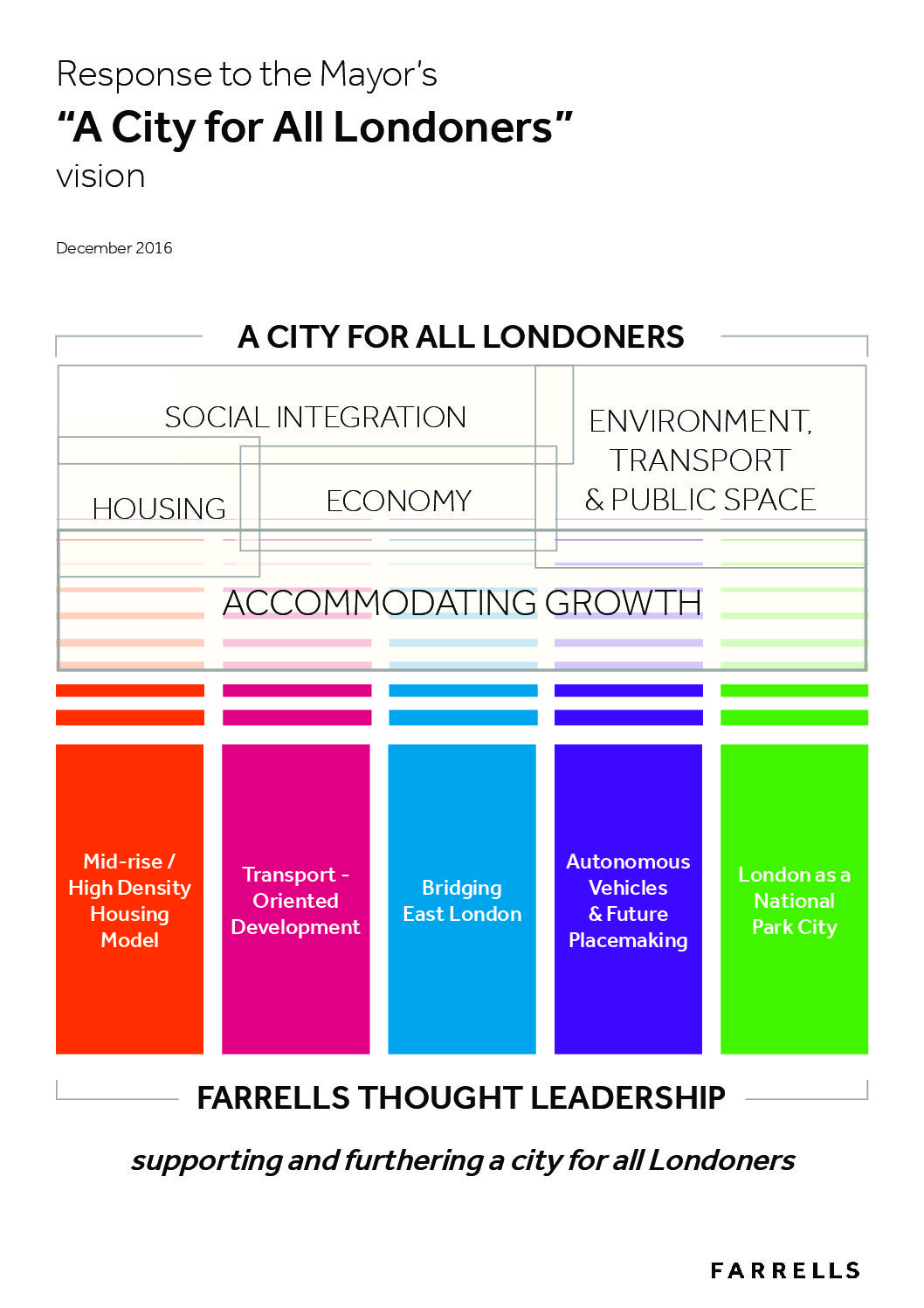

A City for All Londoners
Our Response to the Mayor’s Vision
Farrells has been developing a vision for the future of London that is very closely related to the one presented in “A City for All Londoners”; all in all, we can help. Farrells has always been a practice highly engaged with urban issues, particularly those of London, and every part of our vision builds on our extensive experience with holistic, collaborative, place-based masterplanning and urban design.
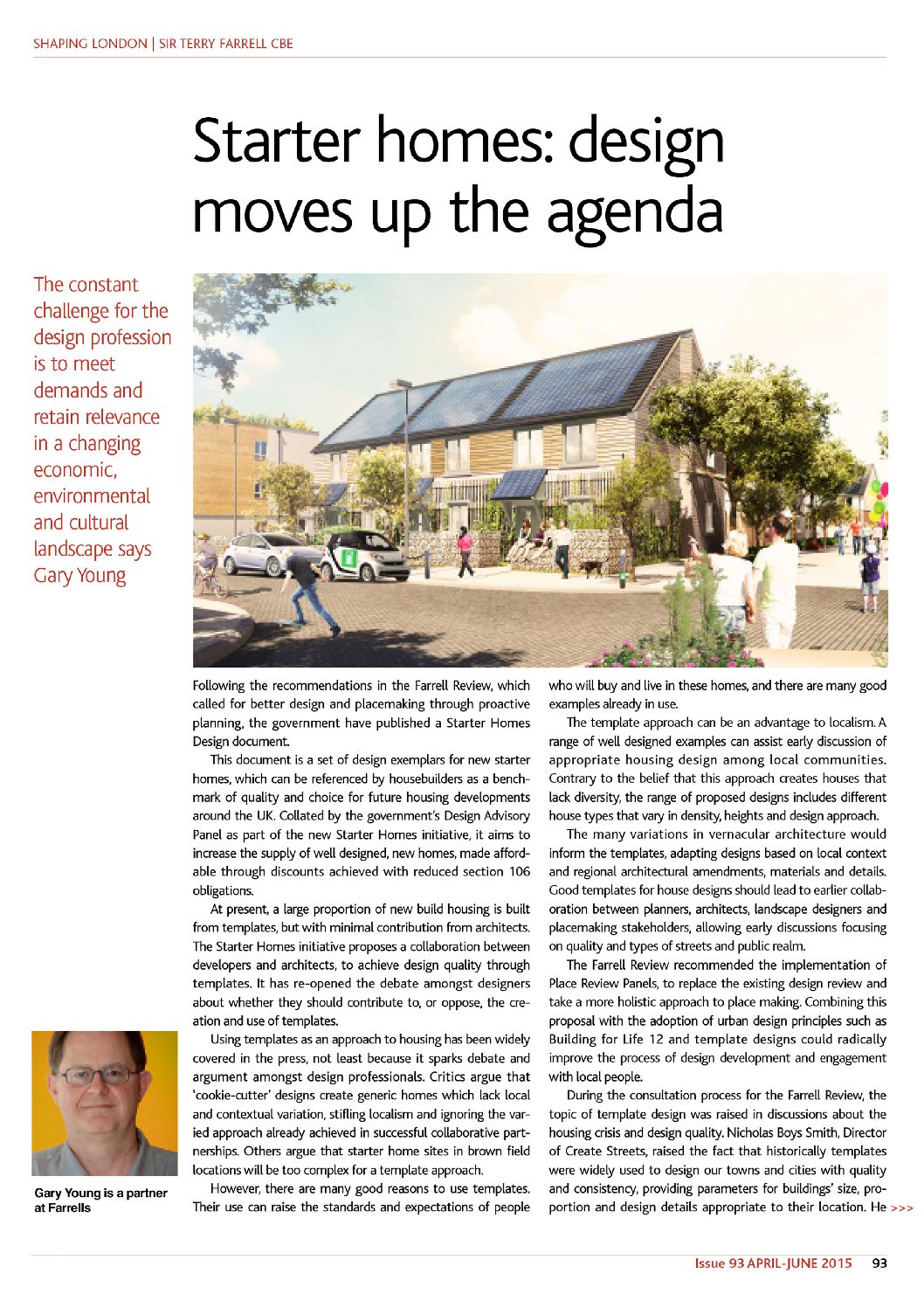

Starter homes: design moves up the agenda
Planning in London April 2015
The constant challenge for the design profession is to meet demands and retain relevance in a changing economic, environmental and cultural landscape says Farrells Partner Gary Young.
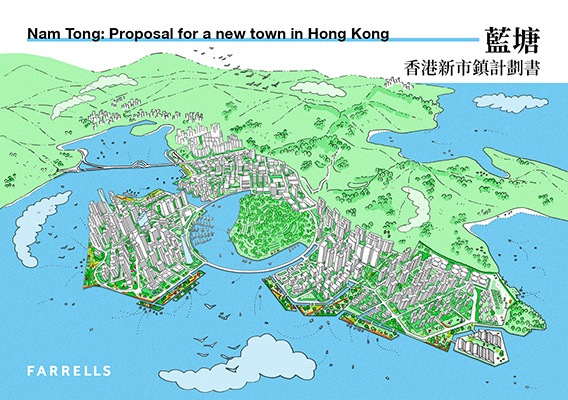
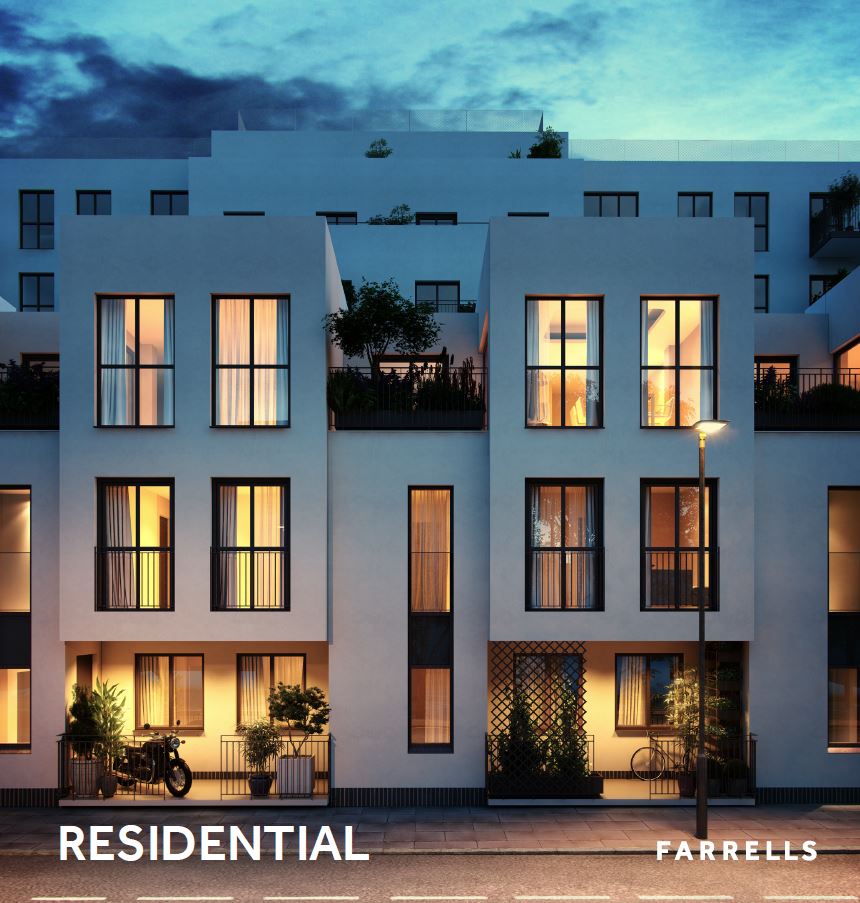

Farrells Residential Brochure
Farrells London
Farrells has a proud 50-year pedigree of delivering housing that works brilliantly at every level and for every stakeholder.
A globally recognised leader in the realm of masterplanning and urban design, Farrells understands what makes a space a place: A plot is a community; a house is a home for someone to spend their life in. Furthermore, projects truly in tune with the local culture and context create greater long term value, for investors, residents and the wider community.
This core belief is utterly consistent with the origins of Farrells 50 years ago, challenging the then orthodoxy with a ‘bottom up’ rather than ‘top down’ view of how architectural work is approached. This ethos remains critical today in a world where local identity is becoming increasingly important and evermore valued.
For this to happen, though, we match the passion of our clients and work closely with them and local authorities to achieve their ambitions. This ultimately improves our work and results in projects that amplify existing heritage, inflected with modern architectural flourishes.
In this respect, completion is just as, if not more, important than conception. Good schemes deserve delivery and Farrells produce working drawings for clients to see projects through from start to finish.
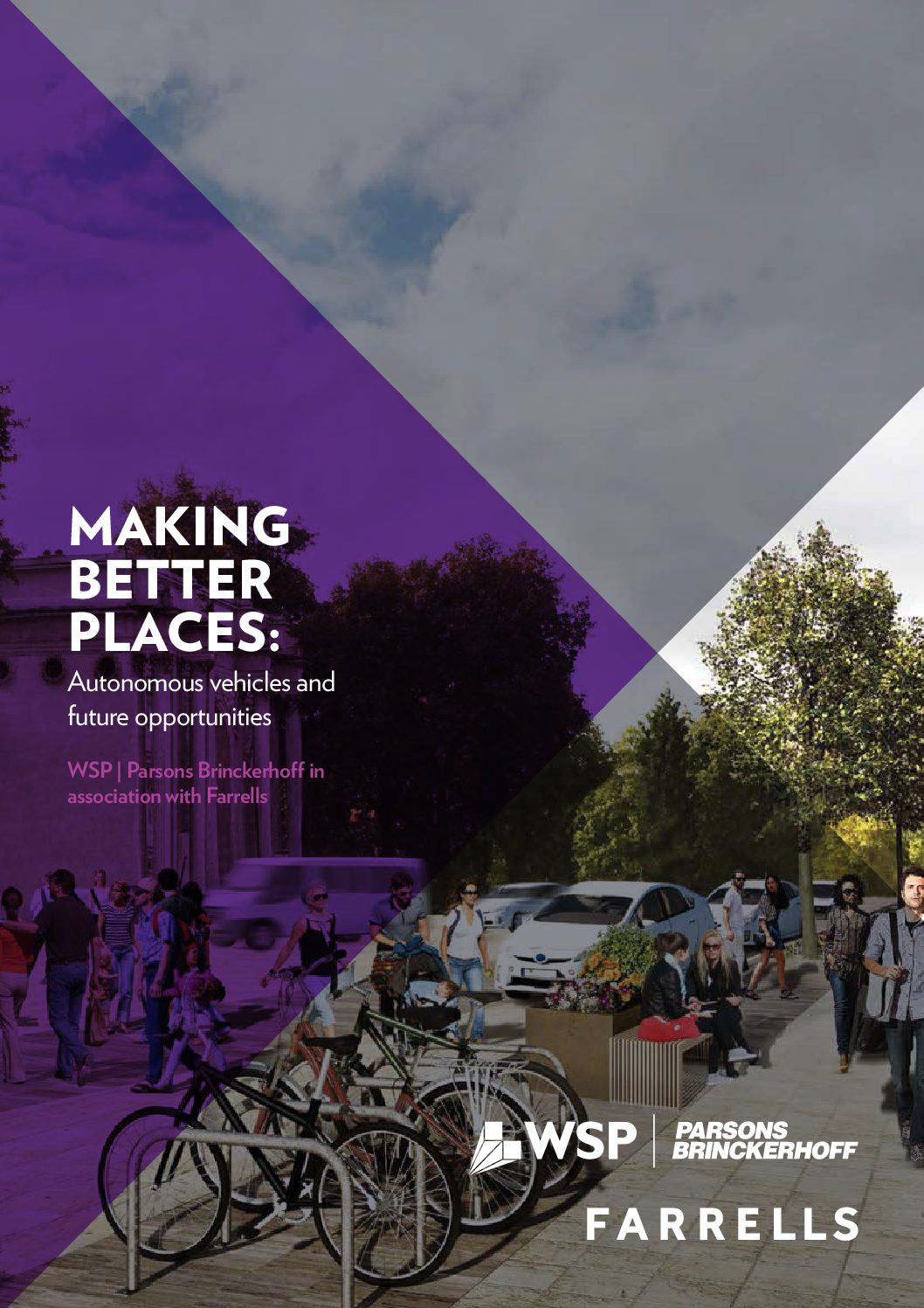

Making Better Places: Autonomous Vehicles
WSP | Parsons Brinckerhoff in association with Farrells
Autonomous vehicles will be transformational. They have the potential to
support a better quality of life, economic growth, health, safety and social
connections. They offer convenient and affordable mobility to all of us,
regardless of where we live, our age or ability to drive. They could also help
to improve the way that our existing places and routes work, while offering
new potential for more valuable land, and additional homes and jobs.
Working together, WSP | Parsons Brinckerhoff and Farrells have built on
leading-edge research into connected and autonomous vehicles to explore
new thinking and ideas. From this, we have created future visions of what we
think five places in the UK might look like in an autonomous vehicle world.
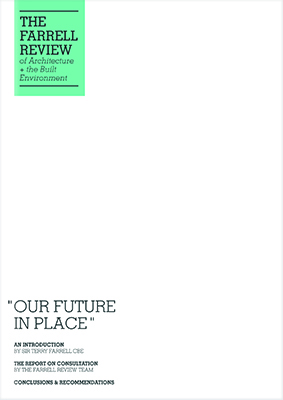

The Farrell Review
The Farrell Review of Architecture & the Built Environment
In January 2013 Ed Vaizey, then Minister for Culture, Communications and the Creative Industries, asked Farrells to undertake a national review of architecture and the built environment. Advised by a panel of eleven industry leaders with a breadth of experience that covers education, outreach, urbanism, architecture, property and philosophy, the Review has been described as “the most thorough and wide-ranging exercise that has taken place in this sector for generations”.
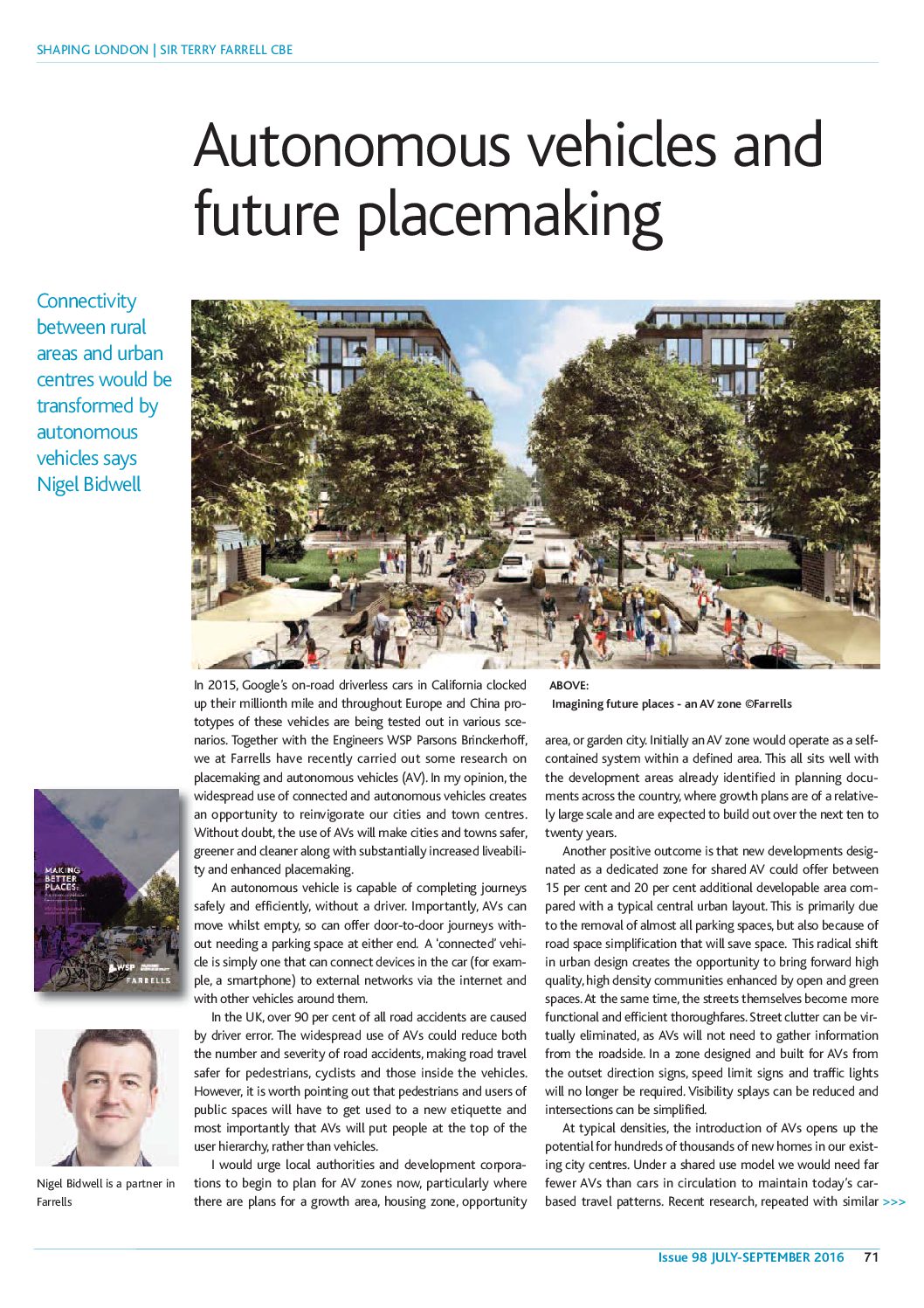

Autonomous vehicles and future placemaking
Planning in London July 2016
Connectivity between rural areas and urban centres would be transformed by autonomous vehicles says Nigel Bidwell.
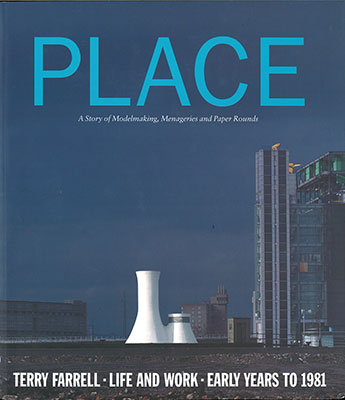

Place
A Story of Modelmaking, Menageries and Paper Rounds: Terry Farrell - Life and Work - Early Years to 1981
As one of the world’s foremost architects and urban designers, Sir Terry Farrell has an acute awareness of the significance of place. Starting from his earliest years, as a child growing up in 1940s Manchester, Farrell’s imagination has been shaped and inspired by the many cities in which he has lived, visited and worked. This is Farrell’s story, embracing four decades of observation of our built environment.
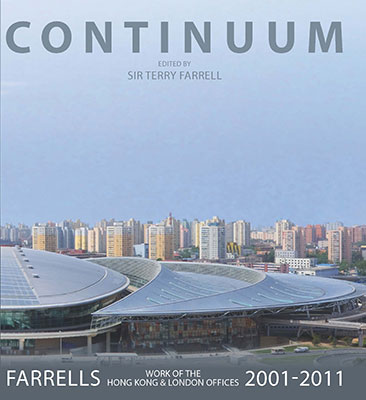

Continuum
Work of the Hong Kong & London Offices
Continuum focuses on the work of Farrells between 2001 and 2011. The book includes such major works as the Home Office Building in London and Guangzhou station in China, which will be the largest railway station in the world. As well as several other major projects in the UK and China, there are also buildings and masterplans from Australia, South Africa, Singapore and India.
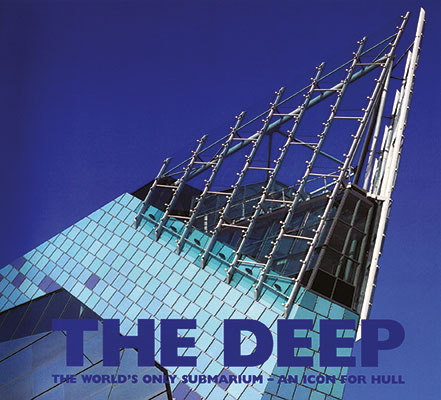

The Deep
The World's Only Submarium - An Icon for Hull
A totally new concept in visitor attraction, the Submarium is a dramatic fusion of aquaria and state of the art interactives telling the story of the world’s oceans through time, latitude and depth. Part of the regeneration of Hull, The Deep has become an internationally recognised landmark and project the pioneering heart of the 2017 UK City of Culture.
This book describes the project from conception through to completion in full-colour photos, text, and plans.
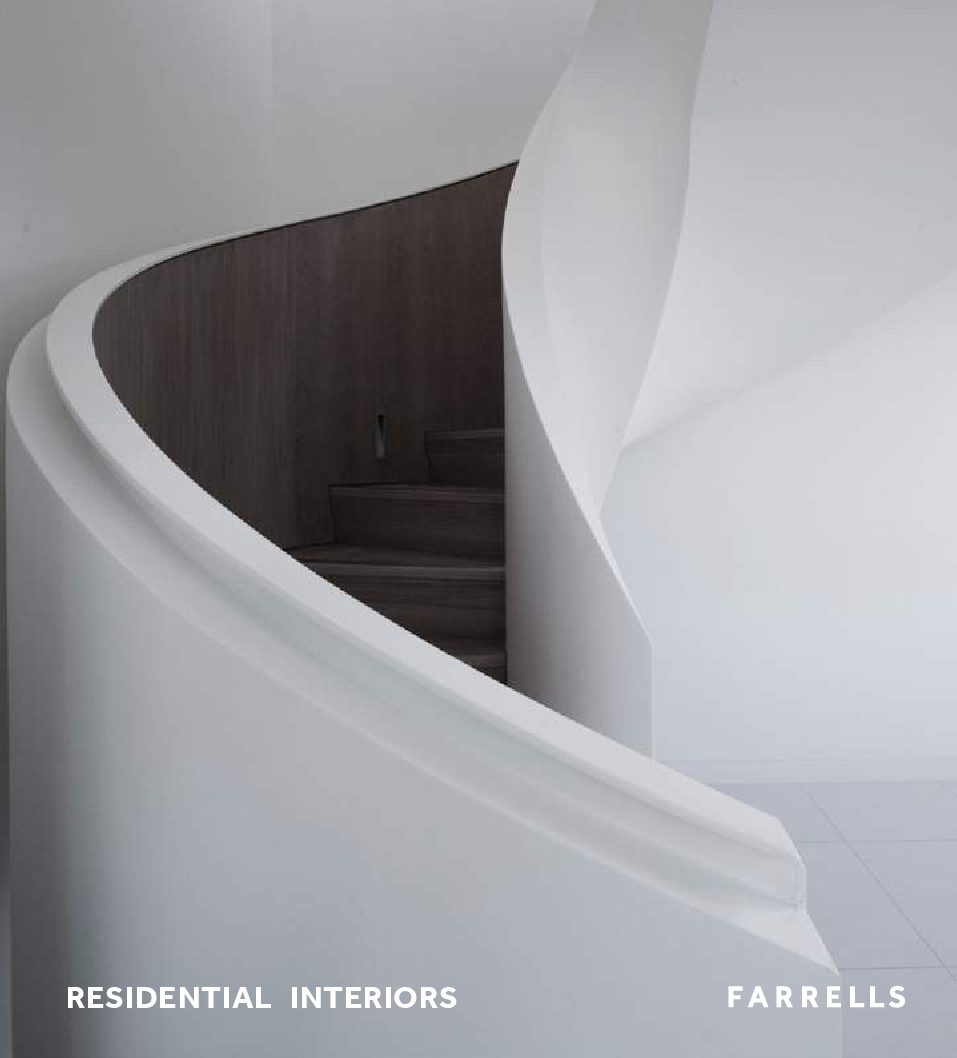

Farrells Residential Interiors Projects
Farrells London
Farrells offer world class interior design with an international brand and a profound understanding of London’s residential markets. We have designed award winning interiors within our own architectural projects as well as buildings designed by others for over fifty years.
